| Mallard: "In A Different Climate" (Virgin, Jan. 1976) |
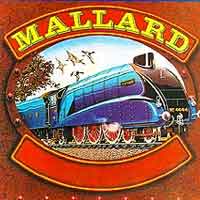 Die
erste Platte von Mark Boston, Bill Harkleroad und Art
Tripp III, besser bekannt als "Rockette Morton", "Zoot
Horn Rollo" und "Ed Marimba" aus Captain Beafheart's
Magic Band von "Trout Mask Replica"
(1969) bis "Unconditionally Guaranteed" (1974). Es gibt sogar
eine Coverversion vom texanischen Songschreiber Guy
Clark: "Desperados Waiting For The Train". Bezahlt hatte
diese Plattenaufnahme übrigens Ian Anderson von Jethro
Tull, ein großer Beefheart-Fan. Die
erste Platte von Mark Boston, Bill Harkleroad und Art
Tripp III, besser bekannt als "Rockette Morton", "Zoot
Horn Rollo" und "Ed Marimba" aus Captain Beafheart's
Magic Band von "Trout Mask Replica"
(1969) bis "Unconditionally Guaranteed" (1974). Es gibt sogar
eine Coverversion vom texanischen Songschreiber Guy
Clark: "Desperados Waiting For The Train". Bezahlt hatte
diese Plattenaufnahme übrigens Ian Anderson von Jethro
Tull, ein großer Beefheart-Fan. |
| Ougenweide: "Ohrenschmaus" (Polydor, Jan. 1976) |
|
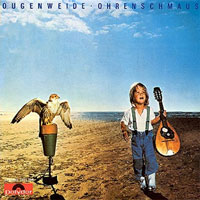 Spätestens
seit diesem dritten Album bzw. seit den ausgedehnten Touren 1974/75
zum erfolgreichen zweiten Album "All
Die Weil Ich Mag" gehörte die Hambuger Folkrockband zuer
ersten Garnitur deutscher Rockbands. Spätestens
seit diesem dritten Album bzw. seit den ausgedehnten Touren 1974/75
zum erfolgreichen zweiten Album "All
Die Weil Ich Mag" gehörte die Hambuger Folkrockband zuer
ersten Garnitur deutscher Rockbands.
(17.07.2010)
|
| Jess Roden Band: "Keep Your Hat On" (Island, Jan. 1976) |
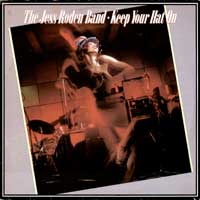 Ein
gutes Beispiel dafür, dass Talent und Erfolg nicht unbedingt zusammenfinden
müssen: Jess Roden ist einer der besten englischen Rock/Soul-Sänger
und gehört in eine Reihe mit Rod Stewart, Steve Winwood, Paul Carrack
und Robert Palmer, ohne allerdings jemals deren Bekanntheitsgrad erreicht
zu haben. Nach zwei Alben mit der Countryrockband Bronco,
einem kurzen Abstecher bei der Butts Band
mit Robbie Krieger und John Densmore als Jim Morrison-Ersatz
und einer zwar sehr schönen, aber erfolglosen Soloplatte, in New
Orleans mit dem Produzenten Allan Toussaint und den Meters
als Begleitband aufgenommen, gründete er seine eigene Band, mit der
er es innerhalb kürzester Zeit immerhin auf 2 Studio- und ein Livealbum
brachte. Alle drei Platten präsentieren wunderbaren Soulrock. Ausgewählt
habe ich das Debütalbum der Band, dass ich irgendwann mal für
ein paar Mark aus der Grabbelkiste gezogen habe: der Platz, an dem (leider)
viele gute Platten landen (und eines meiner Hauptjagdreviere!). Die Band
ohne bekannte Gesichter spielt ausgezeichnet: Steve Webb und Bruce
Roberts an den Gitarren, Pete Hunt (dr) und John Cartwright
(bg) in der Rhythmusgruppe und Chris Gower (Posaune) und Ronnie
Taylor (Sax) als fester Bläsersatz. Die Songs stammen zur einen
Hälfte von Bandmitgliedern (Roden, Webb und Cartwright), es gibt
aber auch tolle Coverversionen aus den Bereichen Rock, Soul & Country:
das Titelstück "You Can Leave Your Hat On" von Randy
Newman (hier viel besser als bei Josef Cocker aufgehoben!), "Mama
Roux" (Dr. John), "Desperado" von den Eagles
(besser als das Original!) und die Nashvilleballade "Too Far Gone"
(Billy Sherrill). Ein
gutes Beispiel dafür, dass Talent und Erfolg nicht unbedingt zusammenfinden
müssen: Jess Roden ist einer der besten englischen Rock/Soul-Sänger
und gehört in eine Reihe mit Rod Stewart, Steve Winwood, Paul Carrack
und Robert Palmer, ohne allerdings jemals deren Bekanntheitsgrad erreicht
zu haben. Nach zwei Alben mit der Countryrockband Bronco,
einem kurzen Abstecher bei der Butts Band
mit Robbie Krieger und John Densmore als Jim Morrison-Ersatz
und einer zwar sehr schönen, aber erfolglosen Soloplatte, in New
Orleans mit dem Produzenten Allan Toussaint und den Meters
als Begleitband aufgenommen, gründete er seine eigene Band, mit der
er es innerhalb kürzester Zeit immerhin auf 2 Studio- und ein Livealbum
brachte. Alle drei Platten präsentieren wunderbaren Soulrock. Ausgewählt
habe ich das Debütalbum der Band, dass ich irgendwann mal für
ein paar Mark aus der Grabbelkiste gezogen habe: der Platz, an dem (leider)
viele gute Platten landen (und eines meiner Hauptjagdreviere!). Die Band
ohne bekannte Gesichter spielt ausgezeichnet: Steve Webb und Bruce
Roberts an den Gitarren, Pete Hunt (dr) und John Cartwright
(bg) in der Rhythmusgruppe und Chris Gower (Posaune) und Ronnie
Taylor (Sax) als fester Bläsersatz. Die Songs stammen zur einen
Hälfte von Bandmitgliedern (Roden, Webb und Cartwright), es gibt
aber auch tolle Coverversionen aus den Bereichen Rock, Soul & Country:
das Titelstück "You Can Leave Your Hat On" von Randy
Newman (hier viel besser als bei Josef Cocker aufgehoben!), "Mama
Roux" (Dr. John), "Desperado" von den Eagles
(besser als das Original!) und die Nashvilleballade "Too Far Gone"
(Billy Sherrill). |
| Bob Dylan: "Desire" (Columbia, Jan. 1976) |
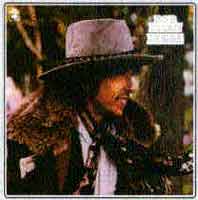 "Desire"
ist das Album nach dem Meisterwerk "Blood
On The Tracks", die meisten Songs hat Dylan (sehr ungewöhnlich
für ihn) zusammen mit dem Texter Jacques Levy geschrieben,
herausragend sind dabei "Hurricane", "Joey", "Oh
Sister", "One More Cup Of Coffee" und "Sara".
Außerdem ist eine komplett neue Begleitband zu hören, in der diesesmal
sogar zwei Frauen auffallen: Emmylou Harris
singt wie zuvor bei Gram Parsons fast durchgängig zweite Stimme,
Scarlet Riveras Geige dominiert die meisten Songs. "Desire"
ist das Album nach dem Meisterwerk "Blood
On The Tracks", die meisten Songs hat Dylan (sehr ungewöhnlich
für ihn) zusammen mit dem Texter Jacques Levy geschrieben,
herausragend sind dabei "Hurricane", "Joey", "Oh
Sister", "One More Cup Of Coffee" und "Sara".
Außerdem ist eine komplett neue Begleitband zu hören, in der diesesmal
sogar zwei Frauen auffallen: Emmylou Harris
singt wie zuvor bei Gram Parsons fast durchgängig zweite Stimme,
Scarlet Riveras Geige dominiert die meisten Songs. |
| Guy Clark: "Texas Cooking" (RCA, Jan. 1976) |
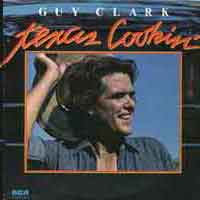 Das
zweite Album des texanischen Geschichtenerzähler, wie schon beim
ersten Mal mit ausgezeichneten Begleitern (Rodney
Crowell, Emmylou Harris, Jerry
Jeff Walker, Nicolette Larson,
Tracy Nelson, Waylon Jennings, Hoyt Axton,
u. a.) und exquisitem Songmaterial (z.B. der Titelsong, "Broken Hearted
People" und "Last Gunfighter Ballad") Das
zweite Album des texanischen Geschichtenerzähler, wie schon beim
ersten Mal mit ausgezeichneten Begleitern (Rodney
Crowell, Emmylou Harris, Jerry
Jeff Walker, Nicolette Larson,
Tracy Nelson, Waylon Jennings, Hoyt Axton,
u. a.) und exquisitem Songmaterial (z.B. der Titelsong, "Broken Hearted
People" und "Last Gunfighter Ballad") |
| Lou Reed: "Coney Island Baby" (RCA, Jan. 1976) |
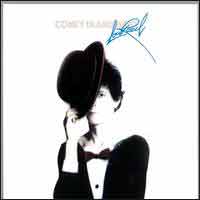 Der Mann hat es seinem Publikum nicht leicht gemacht: ein halbes Jahr
zuvor erschien mit "Metal Machine Music" eine unhörbare
"Krachplatte" im wahrsten Sinne des Wortes, die auch für
meine Ohren zu anstrengend ist. Danach dann mit "Coney Island Baby"
plötzlich wieder eine Platte mit wunderschönen Liedern!
Der Mann hat es seinem Publikum nicht leicht gemacht: ein halbes Jahr
zuvor erschien mit "Metal Machine Music" eine unhörbare
"Krachplatte" im wahrsten Sinne des Wortes, die auch für
meine Ohren zu anstrengend ist. Danach dann mit "Coney Island Baby"
plötzlich wieder eine Platte mit wunderschönen Liedern!

 Mehr ...
Mehr ...
|
"Quiet ballads this time, with stripped down production values that
vaguely recall the Underground's more low-key stuff (the lengthy, nearly
incoherent "Kicks") but are definitely in the 70's art rock
mainstream ("Crazy Feeling," a relatively energetic and memorable
pop song). Reed mostly just strums his guitar, the rhythm section thumps
and bashes along unobtrusively, and the gimmicks are limited: a lot of
slide guitar, a little piano, backwards percussion, and Reed's mannered
and occasionally sloppy backup vocals. Thematically it's pretty much restricted
to romance, unlike Reed's best records, and stylistically it's just as
narrow: the big exception is the rambling, slow-dance pseudo-soul title
track, complete with a slick R & B guitar part and some swaying female
backup vocals. Nothing here matches the overblown pomp of Transformer
or the avant garde mania of the Underground's records, but the songwriting
is mostly solid and there's nothing really offensive - except possibly
the wearying six-minute remake of "She's My Best Friend," which
doesn't have half the spark of the original. Produced by Godfrey Diamond."
|
|
| Jerry Garcia: "Reflections" (Round, Feb. 1976) |
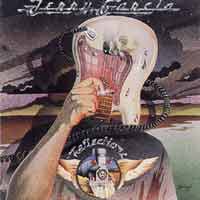 Jerrys drittes Soloalbum, zur Hälfte mit Grateful
Dead, zur Hälfte mit seiner eigenen Band (John Kahn, Nicky
Hopkins und Ron Tutt) eingespielt. Ein paar schöne eigene Songs
(ich mag besonders "Comes A Time"), aber auch ein paar sehr
schöne Coversongs (z.B. das entschleunigte und zum Reggae umgebaute Bluegrassstück
"Catfish John" und das wunderbare "On Your Way Down"
von Allen Toussaint). Das Album ist um Klassen besser als sein
Ruf in der Deadhead-Gemeinde.
Jerrys drittes Soloalbum, zur Hälfte mit Grateful
Dead, zur Hälfte mit seiner eigenen Band (John Kahn, Nicky
Hopkins und Ron Tutt) eingespielt. Ein paar schöne eigene Songs
(ich mag besonders "Comes A Time"), aber auch ein paar sehr
schöne Coversongs (z.B. das entschleunigte und zum Reggae umgebaute Bluegrassstück
"Catfish John" und das wunderbare "On Your Way Down"
von Allen Toussaint). Das Album ist um Klassen besser als sein
Ruf in der Deadhead-Gemeinde.

 Mehr ...
Mehr ...
| The third solo album from Grateful Dead lead guitarist Jerry
Garcia comes as the result of the band's mini-hiatus from touring during
late 1974 and most of 1975. Rather than auditioning a new combo, Garcia
splits Reflections evenly between recordings made with the Dead as well
as his Legion of Mary and Jerry Garcia Band side projects. As with his previous
non-Dead effort, Garcia (Compliments of Garcia), this disc includes a blend
of originals and cover tunes. Astute Deadheads will inevitably recognize
that all four cuts featuring backing by the Dead had been part of their
live repertoire for several years. Although only five of the tracks were
co-authored by Garcia's primary lyrical collaborator, Robert Hunter, all
eight of them remained in Garcia's solo set lists for the balance of his
career. The material on this album is uniformly strong and includes some
of the best studio work that the Dead had been involved in since American
Beauty and Workingman's Dead. Their sound is no longer as rurally influenced;
instead, they adopt an equally laid-back, jazzy approach. This is perhaps
most strikingly evident in the new direction given to "They Love Each
Other." Although initially presented as an up-tempo boogie, by contrast
it is now a slinky, low-key affair. The retooled version became a staple
throughout the Dead's mid-to-late-'70s live sets, occasionally resurfacing
during their waning years. There are more subtle variations on the absolutely
stunning and emotive ballads "Comes a Time" and "Must Have
Been the Roses" -- which also cropped up underneath the closing credits
of the Grateful Dead Movie (1976).
The all-star cast that Garcia assembled for "Mission in the Rain"
-- as well as Allen Toussaint's "I'll Take a Melody," Hank Ballard's
"Tore up Over You," and the Johnny Russell country hit "Catfish
John" -- includes John Kahn (bass), Ron Tutt (drums), Nicky Hopkins
(keyboards), and Larry Knechtel (keyboards). The latter cover tune is
also notable, as both Garcia and Kahn had presented it with a full-throttle
bluegrass attitude during their time in the short-lived Old & in the
Way project. With the exception of Knechtel, the remaining trio continued
to perform in the Jerry Garcia Band during the mid-'70s. -- Lindsay Planer
(AMG)
|
|
| Guru Guru: "Tango Fango" (Brain, Feb. 1976) |
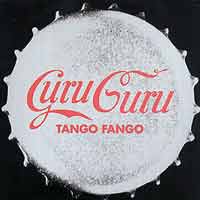 Dieser Platte hat mich immer zum Lachen gebracht. Guru Guru '76 haben nicht
mehr viel mit dem "Spacerock" vom Anfang der 70er zu tun.
Stattdessen hören wir relativ "normalen" Rock mit Jazz-,
Latin- und Alpenfolklore(!)-Einflüssen. Dazu kommen Nonsens-Texte
und kleine Hörspiele. Neben dem Bandgründer und Trommler Mani
Neumeier gehören Ex-Brainstorm-Musiker
Roland Schaeffer (Gitarre, Sax, Gesang), der Krefelder Jogi
Karpenkiel (Bass) und der österreicher Sepp Jandrisits
(Gitarre, Akkordeon) zur aktuellen Besetzung.
Dieser Platte hat mich immer zum Lachen gebracht. Guru Guru '76 haben nicht
mehr viel mit dem "Spacerock" vom Anfang der 70er zu tun.
Stattdessen hören wir relativ "normalen" Rock mit Jazz-,
Latin- und Alpenfolklore(!)-Einflüssen. Dazu kommen Nonsens-Texte
und kleine Hörspiele. Neben dem Bandgründer und Trommler Mani
Neumeier gehören Ex-Brainstorm-Musiker
Roland Schaeffer (Gitarre, Sax, Gesang), der Krefelder Jogi
Karpenkiel (Bass) und der österreicher Sepp Jandrisits
(Gitarre, Akkordeon) zur aktuellen Besetzung.
|
| Kursaal Flyers: "The Great Artiste" (Polydor/UK, Feb. 1976) |
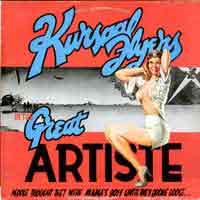 Mitten in den 70ern in England so was wie Country-Pubrock spielen? Mit
Reggae-Elementen? Mit Banjo, Pedal-Steel und Moog-Synthesizer? Und der
Trommler schreibt die Songs? Bescheuert? Vielleicht. Aber eben auch was
für Leute mit schrägem Geschmack wie mich. Und mit einer der
besten Coverversionen von einem Nick-Lowe-Song:
"Television".
Mitten in den 70ern in England so was wie Country-Pubrock spielen? Mit
Reggae-Elementen? Mit Banjo, Pedal-Steel und Moog-Synthesizer? Und der
Trommler schreibt die Songs? Bescheuert? Vielleicht. Aber eben auch was
für Leute mit schrägem Geschmack wie mich. Und mit einer der
besten Coverversionen von einem Nick-Lowe-Song:
"Television".

 Mehr ...
Mehr ...
The Kursaal Flyers bridged the gap between pub rock and power pop, turning out a handful of fine albums and great singles in their brief two-year career. Comprised of Paul Shuttleworth (vocals), Graeme Douglas (guitar), Vic Collins (guitar, steel guitar, vocals), Riche Bull (bass, vocals), and Will Birch (drums), the band released their first album, Chocs Away, in 1975; it was followed soon afterward by The Great Artiste. Both records showed a grasp of country and roots rock, as well as pure pop. They would begin to emphasize their pop elements with 1976's Golden Mile, released by CBS Records. The union with the major label helped the single "Little Does She Know" reach the British Top 20. Douglas left to join Eddie & the Hot Rods before the recording of their final album, Five Live Kursaals (1977); he was replaced by Barry Martin. The band broke up after the release of punk- and power pop-injected Five Live Kursaals. Out of the members, only Will Birch and John Wicks stayed active � they formed the Records immediately after the Kursaal Flyers' disbandment. The Kursaal Flyers reunited in 1988, recording A Former Tour de Force Is Forced to Tour, which picks up right where they left off in 1977.
(by Stephen Thomas Erlewine, All Music Guide)
|
| Pat Metheny: "Bright Size Life" (ECM, Feb. 1976) |
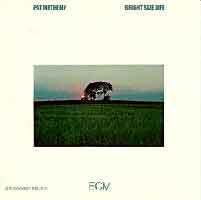 Das Solodebüt des damals noch sehr jungen Gitarristen, im Trio mit
Billy Hart am Schlagzeug und dem ebenfalls noch sehr jungen Jaco
Pastorius am Bass eingespielt.
Das Solodebüt des damals noch sehr jungen Gitarristen, im Trio mit
Billy Hart am Schlagzeug und dem ebenfalls noch sehr jungen Jaco
Pastorius am Bass eingespielt.

 Mehr ...
Mehr ...
"Pat Metheny's debut studio album is a good one, a trio date that
finds him already laying down the distinctively cottony, slightly withdrawn
tone and asymmetrical phrasing that would serve him well through most
of the swerves in direction ahead. His original material, all of it lovely,
bears the bracing air of his Midwestern upbringing, with titles like "Missouri
Uncompromised," "Midwestern Nights Dream" and "Omaha
Celebration." There is also a sole harbinger of radical matters way
down the road with the inclusion of a loose-jointed treatment of Ornette
Coleman's "Round Trip/Broadway Blues," proving that Song X did
not come from totally out of the blue. Besides the debut of Metheny, this
CD also features one of the earliest recordings of Jaco Pastorius, a fully
formed, well-matched contrapuntal force on electric bass, though content
to leave the spotlight mostly to Metheny. Bob Moses, who like Metheny
played in the Gary Burton quintet at the time, is the drummer, and he
can mix it up, too."
(Richard S. Ginell, All Music Guide)
|
| Hoelderlin: "Clowns & Clouds" (Intercord/Spiegelei, März 1976) |
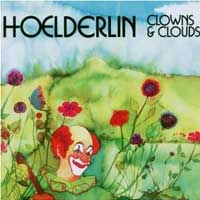 Lost And Found!
Lost And Found!
(Februar 2007)

 Mehr ...
Mehr ...
|
Das Album von 1976. Ein Konzeptalbum mit orchestralen Anwandlungen wie
mit einigen bissigeren musikalischen Extravaganzen. Vor allem weil Saxophonist
Büdi Siebert einigen Freiraum genoss. Auch hier ein Bonus-Track (Traum
- Live 1974)
(Glitterhouse)
|
|
| "Kingfish" (Round, März 1976) |
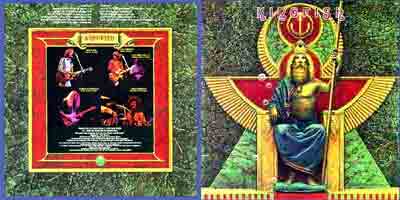 1976 legten die Grateful Dead eine Pause ein und der rastlose Bob
Weir machte Kingfish zu seiner neuen Truppe, ohne dort allerdings
im Mittelpunkt zu stehen. Zwei seiner Freunde, der Harpspieler und Slidegitarrist
Matt Kelly, sowie der Sänger und Bassist Dave Torbert
(Ex-New Riders Of The Purple Sage) spielten
schon seit 1973 unter dem Name "Kingfish" zusammen, bekamen
aber durch den prominenten Neuzugang einen Schub nach vorne, sodass es
zu dieser Studioplatte und einem Livealbum auf dem Grateful-Dead-Label
Round kam. 1977 erschien noch eine weitere Studioplatte ohne Weir
(der wieder voll mit den Dead beschäftigt war) und es gab sogar einen
Rockpalast-Auftritt. Danach verschwand diese tolle Band aber wieder
in der Obskurität.
1976 legten die Grateful Dead eine Pause ein und der rastlose Bob
Weir machte Kingfish zu seiner neuen Truppe, ohne dort allerdings
im Mittelpunkt zu stehen. Zwei seiner Freunde, der Harpspieler und Slidegitarrist
Matt Kelly, sowie der Sänger und Bassist Dave Torbert
(Ex-New Riders Of The Purple Sage) spielten
schon seit 1973 unter dem Name "Kingfish" zusammen, bekamen
aber durch den prominenten Neuzugang einen Schub nach vorne, sodass es
zu dieser Studioplatte und einem Livealbum auf dem Grateful-Dead-Label
Round kam. 1977 erschien noch eine weitere Studioplatte ohne Weir
(der wieder voll mit den Dead beschäftigt war) und es gab sogar einen
Rockpalast-Auftritt. Danach verschwand diese tolle Band aber wieder
in der Obskurität.

 Mehr ...
Mehr ...
|
A side project of Grateful Dead-guitarist Bob Weir, Kingfish was a hot
little bar band that stayed close to rock's roots. There's a very strong
song selection, featuring "Jump for Joy," "Lazy Lightning,"
"Wild Northland," "Big Iron," "Goodby Yer Honor,"
"Asia Minor," and more. Besides Weir, players on this release
include Dave Torbert, Matthew Kelly, Robby Hoddinott, and Chris Herold.
This album featured jams to challenge The Dead's but also knew when to
come back to earth.
(by Jeff Tamarkin & Chip Renner, All
Music Guide)
|
|
| Man: "The Welsh Connection" (MCA, März 1976) |
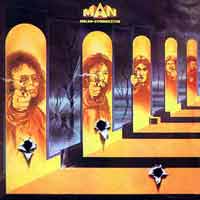 Man letztes Studioalbum vor dem Ende der Band sollte eigentlich ein Neuanfang
werden: ein neues Plattenlabel, nachdem die "waliser Grateful Dead"
(oder "britischen Allman Brothers") jahrelang bei United Artists
zuhause waren, ein neuer Bassist (John McKenzie, Ex-Global Village
Trucking Company) und an den Keyboards Heimkehrer Phil Ryan.
Beide beflügeln die Altgedienten (Deke Leonard, Micky Jones
und Trommler Terry Williams) zu Höchstleistungen. Vielleicht
ist das nicht das beliebteste Album der Band und auch nicht die populärste
Besetzung - aber sicher die musikalisch beste. Davon kann man sich dann
auch noch auf dem Livealbum "All's Well
That Ends Well" von den Abschiedskonzerten im Dezember 1976 aus
dem Londoner Roundhouse überzeugen, das im Jahr 1977 herauskam und
wohl nur zur Vertragserfüllung diente.
Man letztes Studioalbum vor dem Ende der Band sollte eigentlich ein Neuanfang
werden: ein neues Plattenlabel, nachdem die "waliser Grateful Dead"
(oder "britischen Allman Brothers") jahrelang bei United Artists
zuhause waren, ein neuer Bassist (John McKenzie, Ex-Global Village
Trucking Company) und an den Keyboards Heimkehrer Phil Ryan.
Beide beflügeln die Altgedienten (Deke Leonard, Micky Jones
und Trommler Terry Williams) zu Höchstleistungen. Vielleicht
ist das nicht das beliebteste Album der Band und auch nicht die populärste
Besetzung - aber sicher die musikalisch beste. Davon kann man sich dann
auch noch auf dem Livealbum "All's Well
That Ends Well" von den Abschiedskonzerten im Dezember 1976 aus
dem Londoner Roundhouse überzeugen, das im Jahr 1977 herauskam und
wohl nur zur Vertragserfüllung diente.

 Mehr ...
Mehr ...
|
This was to be Man's last studio album for two decades, and with its
weak sales (it failed to chart) and underpowered material it's easy to
see why the band called it quits for the time being. There's some irony,
then, in the closing track being "Born with a Future." It's
a good final bow, though, as it's well harmonized and ultimately one of
the best cuts on the album. Perhaps this releases's most nagging overall
problem is the mix-Phil Ryan's keyboards are high up, while Deke Leonard's
bracing guitar parts are less evident than usual. Although this isn't
always a liability-the lengthy title track lazily wends its way through
some pleasant moog solos and electric piano flourishes-the grittiness
of the band's sound is largely squandered here.
(by Paul Collins, All
Music Guide)
|
|
| Joe Cocker: "Stingray" (A&M, April 1976) |
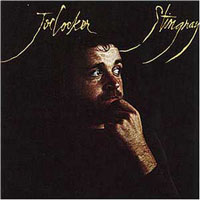 Ich bin eigentlich überhaupt kein Cocker-Fan. Und dies ist sicherlich
weder sein bekanntestes noch sein bestes Album - aber ich mag es sehr:
schöne Songs (meist von Bobby Charles und Matthew Moore),
aber vor allem eingespielt in Jamaika (!) mit einer tollen Band: The
Stuff. Dahinter verbergen sich New-Yorker Studiocracks der ersten
Liga: Gordon Edwards (Bass), Richard Tee (keyboards), Cornell
Dupree und Eric Gale an den Gitarren, sowie Steve Gadd
am Schlagzeug.
Ich bin eigentlich überhaupt kein Cocker-Fan. Und dies ist sicherlich
weder sein bekanntestes noch sein bestes Album - aber ich mag es sehr:
schöne Songs (meist von Bobby Charles und Matthew Moore),
aber vor allem eingespielt in Jamaika (!) mit einer tollen Band: The
Stuff. Dahinter verbergen sich New-Yorker Studiocracks der ersten
Liga: Gordon Edwards (Bass), Richard Tee (keyboards), Cornell
Dupree und Eric Gale an den Gitarren, sowie Steve Gadd
am Schlagzeug.
(03.10.2007)

 Mehr ...
Mehr ...
|
Recorded in Jamaica, Stingray was an attempt to meld Joe's raspy vocals
with reggae music. It was an experiment which had mixed results. Using
crack New York session men instead of Jamaicans somewhat defeated the
purpose, but did work well in off-setting the reggaefied tunes. Joe turns
in a fine vocal performance throughout and shines on such covers as "A
Song For You" and Bob Dylan's "The Man In Me." Stingray
is full of gems worth seeking out.
(by James Chrispell, All
Music Guide)
|
|
| Graham Parker & The Rumour: "Howlin' Wind" (Vertigo, April 1976) |
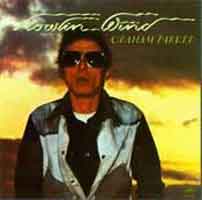 Was
für ein grandioses Debüt: Graham Parker mit seiner Band, in
der sich Musiker von zwei frisch aufgelösten Pubrockbands trafen:
Brinsley Schwarz (g) und Bob Andrews (keyb) kamen von Brinsley
Schwarz, Martin Belmont (g) kam von Ducks
Deluxe, Andy Bodnar (bg) und Steve Goulding (dr) spielten
vorher auch bei einer Pubrockband, deren Name mir aber im Moment leider
nicht einfällt. Produziert hatte Nick Lowe (ebenfalls von
Brinsley Schwarz). Das alles
wäre aber nichts ohne die Songs von Graham Parker: "Between
You And Me", "Don't Ask Me Questions", "Soul Shoes",
"White Honey", etc. Was
für ein grandioses Debüt: Graham Parker mit seiner Band, in
der sich Musiker von zwei frisch aufgelösten Pubrockbands trafen:
Brinsley Schwarz (g) und Bob Andrews (keyb) kamen von Brinsley
Schwarz, Martin Belmont (g) kam von Ducks
Deluxe, Andy Bodnar (bg) und Steve Goulding (dr) spielten
vorher auch bei einer Pubrockband, deren Name mir aber im Moment leider
nicht einfällt. Produziert hatte Nick Lowe (ebenfalls von
Brinsley Schwarz). Das alles
wäre aber nichts ohne die Songs von Graham Parker: "Between
You And Me", "Don't Ask Me Questions", "Soul Shoes",
"White Honey", etc. |
| Pavlov's Dog: "At The Sound Of The Bell" (Columbia, April 1976) |
|
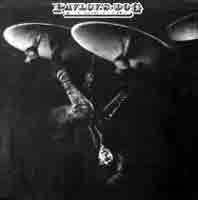 Die Experten streiten, welches von den beiden Alben der Band aus St.
Louis das bessere ist. Ich habe mich hier wegen "She Came
Shining" und "Standing Here With You" für dieses
zweite entschieden. Beeindruckend bei der Band war immer der hohe Gesang
von David Surkamp - mit niemandem anderen vergleichbar. Nach
dieser Platte verschwand Surkamp wieder in der Versenkung, tauchte nur
mal kurz 1982/83 in der Band Hi-Fi
mit Iain Matthews wieder auf.
Die Experten streiten, welches von den beiden Alben der Band aus St.
Louis das bessere ist. Ich habe mich hier wegen "She Came
Shining" und "Standing Here With You" für dieses
zweite entschieden. Beeindruckend bei der Band war immer der hohe Gesang
von David Surkamp - mit niemandem anderen vergleichbar. Nach
dieser Platte verschwand Surkamp wieder in der Versenkung, tauchte nur
mal kurz 1982/83 in der Band Hi-Fi
mit Iain Matthews wieder auf.
Im Frühjahr 2007 habe ich die reformiere Band (natürlich
mit David Surkamp und Mike Safron, dem Trommler vom ersten Album
"Pampered Menial") in
der Bochumer Zeche erstmals live gesehen - und war so begeistert wie
lange nicht mehr! Seit wenigen Tage habe ich auch eine CDR-Kopie vom
Album als Ersatz für meine alte LP und muss beim Hören mein
obiges Urteil ein wenig korrigieren: die Sequenz der ersten drei Lieder
("She Came Shining" >> "Standing Here With You"
>>"Mersey") gehört für mich zu den besten
Einstiegssequenzen, die ich von Schallplatten kenne. Danach fällt
das Album zwar ein ganz klein wenig ab, aber bis dahin gilt: Absolut
großartig!
(07.10.2007)

 Mehr ...
Mehr ...
Das 1976 erschienene, zweite Album der Band wird von einigen Kritikern als ihr bestes Werk bewertet
Mit den Gastmusikern Bill Bruford, Michael Brecker, Andy Mackay (Roxy Music) und Elliott Randall (Steely Dan)
Produziert von Sandy Pearlman und Murray Krugman (Blue Öyster Cult)
Sie gelten als Kultlegenden und als Vorreiter der Prog Rock-Welle der frühen Siebziger: Die US-Band fasziniert seit mittlerweile einem halben Jahrhundert mit ihrer eigenwilligen Mischung aus Jazz, Hard Rock, Klassik und Folklore. Mit dem zweiten Album haben David Surkamp und seine Mannen deutlich melodischere, sogar poppige, Töne angeschlagen, die für viele Hörer positiver aufgenommen wurden als die bewusst sperrigen Sounds des Debütalbums.
Pavlov's Dog lead singer David Surkamp was everything that was wrong with the band's Columbia debut Pampered Menial. Tempered here by Blue Oyster Cult producers Murray Krugman and Sandy Pearlman, who also recorded the first disc, the sound is more appealing to the ear. The question is, where was it going? Too pop for progressive rock, and too progressive for Top 40, the music is driving and more focused the second time around. There are some heavy guests to add to the festivities, Roxy Music's sax player Andy McKay along with drummer William Bruford and Arista sax player Michael Brecker, though the tracks they appear on are not designated. "Valkerie" has a great hook, of "bring back the good old days," and the production here is cleaner than the first time around, but there is something very left field about this group, extremely non-commercial, even on a pretty ballad like "Standing Here With You (Megan's Song)." The music isn't as artsy as the Mothers of Invention, and certainly not as on target as Blue Oyster Cult, making one wonder if A& man Mark Spector was just being courteous to producers Krugman and Pearlman? Mark Spector had produced Bob Segarini's 1975 effort with Dudes on Columbia, and went on to manage 38 Special, his pop leanings make this signing all the more mysterious. That being said, this outing is actually more pop oriented, or at least as poppy as this style and singer may want to be. "Try to Hang On" is light and listener friendly, one of the best tracks on the album; it is followed by "Gold Nuggets" which is almost a continuation of "Try to Hang On." "She Breaks Like Morning Sky" interrupts the flow a bit, driving a little harder, but the performance is still light years beyond the previous album. The producers have brought the music up in the mix, and the skillful playing of Pampered Meniel is brought a few notches up. "Early Morning On" is a superior track, musically, and though Surkamp is more subdued, it is still his voice which throws the monkey wrench into this affair. The cover concept with model Michael Mantel dressed as the Hunchback of Notre Dame and swinging upside down from bells is very cool, while the mascot from the previous album's cover, the 1849 artwork/engravings by Robert Vernon, appears again on the record sleeve/lyric sheet. At the risk of sounding cruel to the lead vocalist/writer/co-writer of all the songs, both albums would work better as instrumentals — David Surkamp's voice a little too grating for the elegant and complex music inside these grooves. Adventurous and meaningful, The Sound of the Bell is a great concept and musical experience that falls short. Have to give them A for effort, though.
(by Joe Viglione , All Music Guide)
|
| Missus Beastly: "Dr. Aftershave & The Mixed-Pickles" (April/Schneeball, April 1976) |
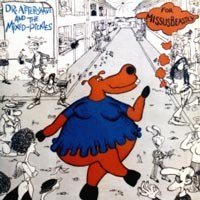 Eine meiner lange nicht gehörten Schallplatten aus vergangener Zeit mit
verwirrenden Namen! Zum einen hiess eines der ersten deutschen Independent-Labels
damals noch "April", bevor es sich unter juristischem
Druck einer großen Plattenfirma, die bereits eine Label mit diesem
Namen hatte, in "Schneeball" umtaufte. "For
Missus Beastly" war die erste Veröffentlichung des Labels
und stammte - nach meinem damaligen Kenntnisstand - von der Band
"Dr. Aftershave & The Mixed-Pickles". Aber
eigentlich handelt es sich um ein Album der ursprünglich aus
Ostwestfalen stammenden Band "Missus Beastly",
die entweder großem Humor hatte oder noch bei einer anderen Firma
unter Vertrag war, sodass sie ein Pseudonym brauchte. Oder beides.
Eine meiner lange nicht gehörten Schallplatten aus vergangener Zeit mit
verwirrenden Namen! Zum einen hiess eines der ersten deutschen Independent-Labels
damals noch "April", bevor es sich unter juristischem
Druck einer großen Plattenfirma, die bereits eine Label mit diesem
Namen hatte, in "Schneeball" umtaufte. "For
Missus Beastly" war die erste Veröffentlichung des Labels
und stammte - nach meinem damaligen Kenntnisstand - von der Band
"Dr. Aftershave & The Mixed-Pickles". Aber
eigentlich handelt es sich um ein Album der ursprünglich aus
Ostwestfalen stammenden Band "Missus Beastly",
die entweder großem Humor hatte oder noch bei einer anderen Firma
unter Vertrag war, sodass sie ein Pseudonym brauchte. Oder beides.
Die Musik? Krautiger Jazzrock bzw. jazziger Krautrock, wie ihn auch ähnlich
Embryo spielen, mit denen Missus
Beastly auch das Label aus der Taufe gehoben hatten und von denen
gleich mehrere Musiker bei den Sessions dabei waren.
(27.01.2010)

 Mehr ...
Mehr ...
Dr. Aftershave and the mixed-pickles' (April 00001) was Missus Beastly's third album, which once more presented some solid jazz rock, mostly instrumental. It was at the same time the first album to be released on April, the new self-distributing label run by Missus Beastly, Ton Steine Scherben, Embryo, and Sparifankal. The LP was recorded in the well-known Stuttgart Zuckerfabrik studio (a former sugar refinery) at the beginning of 1976. The two CD bonus tracks were recorded at the Vlotho festivals ('Umsonst und drau�en' [outside and for free]) 1976 and 1977. At that time, they were presented on the annual festival LPs. 'Dr. Aftershave' was actually planned to be released on CD years ago, but some unexpected obstacles caused a long delay. The fourth and last Missus Beastly LP, 'Space guerilla' from 1978, will soon be released on CD, again provided with bonus tracks.
'Dr. Aftershave and the mixed-pickles' (April 00001) war die dritte LP von Missus Beastly und brachte wieder gediegenen Jazzrock mit nur ganz sp�rlichem Gesang. Gleichzeitig war es die erste auf April erschienene Platte, dem neuen Label und Eigenvertrieb, dem auch Ton Steine Scherben, Embryo und Sparifankal angeh�rten. Aufgenommen wurde die LP Anfang 1976 in der bekannten Zuckerfabrik in Stuttgart. Die beiden CD-Zusatzst�cke stammen von den Vlotho-Festivals ('Umsonst und drau�en') 1976 und 1977. Sie waren damals auf den j�hrlichen Festival-LPs untergebracht. Eigentlich sollte 'Dr. Aftershave' schon vor Jahren als CD erscheinen, doch gab es dabei unerwartete Hindernisse. Die vierte und letzte Missus-Beastly-LP, 'Space guerilla' von 1978, wird in absehbarer Zeit als CD folgen, wieder mit Zusatzst�cken aufgef�llt.
(www.green-brain-krautrock.de)
|
| Michael Pinder: "The Promise" (Threshold, April 1976) |
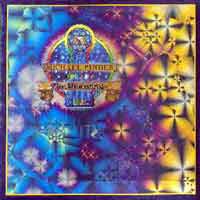 Das einzige Soloalbum des Moody Blues-Keyborders habe ich mir damals
eigentlich nur gekauft, weil es eben etwas mit den Moody Blues
zu tun hatte. Richtig gut fand ich es nicht mit seinem für die Moodies
untypischen Sound weg vom Mellotron, hin zum laidback-Westcoastsound seiner
Wahlheimat Kalifornien. Nur die jazzige Nummer "Someone To Believe
In" mit dem wuchtigen Kontrabass von Joel Dibartello und der
Flöte von Tom Peterson mochte ich schon immer.
Das einzige Soloalbum des Moody Blues-Keyborders habe ich mir damals
eigentlich nur gekauft, weil es eben etwas mit den Moody Blues
zu tun hatte. Richtig gut fand ich es nicht mit seinem für die Moodies
untypischen Sound weg vom Mellotron, hin zum laidback-Westcoastsound seiner
Wahlheimat Kalifornien. Nur die jazzige Nummer "Someone To Believe
In" mit dem wuchtigen Kontrabass von Joel Dibartello und der
Flöte von Tom Peterson mochte ich schon immer.
Aus der Distanz heraus kann man aber feststellen, dass "The Promise"
eine deutlich höhere Haltbarkeit hat als die Solo- und Duoversuche
seiner Ex-Kollegen Justin Hayward, John Lodge und Ray
Thomas. Wie man(n) sich so täuschen kann ...
(28.02.2010)

 Mehr ...
Mehr ...
A very well-produced solo album filled with lush sounds, but Pinder's narrow vocal range and the absence of any balancing love songs by Justin Hayward or rockers by John Lodge limits the appeal of this album. Unfulfilled promise and dated mystical trappings.
(by Bruce Eder, All Music Guide)
|
| Van Der Graaf Generator: "Still Life" (Charisma, April 1976) |
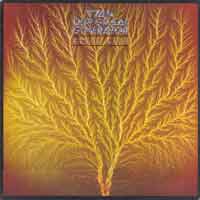 Mein Lieblingsalbum der Band um den Sänger und Songschreiber Peter
Hammill, vor allem wegen der Songs "Pilgrim" und "Still
Life".
Mein Lieblingsalbum der Band um den Sänger und Songschreiber Peter
Hammill, vor allem wegen der Songs "Pilgrim" und "Still
Life".

 Mehr ...
Mehr ...
|
VDGG's second step on the mid-'70s comeback trail saw Peter Hammill attempting
to meld the introspective and the cosmic throughout, though this did not
stop him from taking a dead run at a grandiose concept or two -- the consequences
of immortality on the title track, and the grand fate of humanity on the
epic "Childlike Faith In Childhood's End." The theme of humane
cooperation informed the opening "Pilgrims," while "La
Rossa" is an epic tale of desire fulfilled (a story that would be
concluded on Hammill's solo album, Over). The true highlight, however,
is the beautiful, pensive "My Room (Waiting for Wonderland),"
with its echoes of imagination and loss. Hammill did not achieve such
a level of painful beauty again until "This Side of the Looking Glass"
on Over.
(by Steven McDonald, All
Music Guide)
|
|
| "Cajun Moon" (Chrysalis, Mai 1976) |
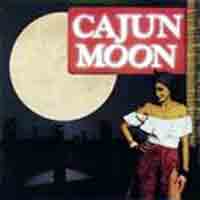 Mal wieder einer der vielen künstlerisch überzeugenden, aber kommerziell
gescheiterten Bandversuche. Allan Taylor, englischer Singer/Songwriter,
versuchte mit seinen Partnern Brian Golbey (Geige) und Jon Gillaspie
(keyb) und einer von Fairport Convention
ausgeliehenen Rhythmusgruppe (Dave Pegg und Dave Mattacks)
und dem Slidegitarren Bryn Haworth
eine Fusion aus Folk und Cajun, England und New Orleans. Klasse zu hören
- kennt aber mal wieder kein Schwein!
Mal wieder einer der vielen künstlerisch überzeugenden, aber kommerziell
gescheiterten Bandversuche. Allan Taylor, englischer Singer/Songwriter,
versuchte mit seinen Partnern Brian Golbey (Geige) und Jon Gillaspie
(keyb) und einer von Fairport Convention
ausgeliehenen Rhythmusgruppe (Dave Pegg und Dave Mattacks)
und dem Slidegitarren Bryn Haworth
eine Fusion aus Folk und Cajun, England und New Orleans. Klasse zu hören
- kennt aber mal wieder kein Schwein! |
| Poco: "Rose Of Cimarron" (MCA, Mai 1976) |
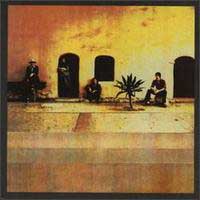 Zu Unrecht haben Poco immer nur am Katzentisch auf dem Olymp des Country-Rocks
gesessen, vielleicht weil ihre Mitglieder entweder von berühmteren
Bands des Genres stammten (die bei "Rose Of Cimarron" nicht
mehr dazugehörigen Richie Furay und Jim Messina kamen
von Buffalo Springfield) oder zu solchen
Bands überliefen (Ur-Bassist Randy Meissner war später
Gründungsmitglied der Eagles,
zu denen auch der aktuelle Bassist Tim Schmitt bald abwandern wird).
Trotz aller Hindernisse wurden Poco als Band und Songschreiber immer besser,
nicht zuletzt deshalb, weil Rusty Young, zu Anfang "nur"
der Pedalsteel-Spieler in der Gruppe, weil man ja mit Furay und Messina
bereits zwei hochkarätige Mitarbeiter in den Arbeitsbereichen Gitarre,
Gesang und Komposition in den eigenen Reihen hatte, eine immer wichtigere
Rolle auch bei diesen Aufgaben erfüllte. So stammt von ihm auch der
von mir in's Herz geschlossene wunderschöne Titelsong, den später
auch Emmylou Harris aufnehmen wird und der auch heutzutage sogar
noch manchmal bei WDR4 zu hören ist!
Zu Unrecht haben Poco immer nur am Katzentisch auf dem Olymp des Country-Rocks
gesessen, vielleicht weil ihre Mitglieder entweder von berühmteren
Bands des Genres stammten (die bei "Rose Of Cimarron" nicht
mehr dazugehörigen Richie Furay und Jim Messina kamen
von Buffalo Springfield) oder zu solchen
Bands überliefen (Ur-Bassist Randy Meissner war später
Gründungsmitglied der Eagles,
zu denen auch der aktuelle Bassist Tim Schmitt bald abwandern wird).
Trotz aller Hindernisse wurden Poco als Band und Songschreiber immer besser,
nicht zuletzt deshalb, weil Rusty Young, zu Anfang "nur"
der Pedalsteel-Spieler in der Gruppe, weil man ja mit Furay und Messina
bereits zwei hochkarätige Mitarbeiter in den Arbeitsbereichen Gitarre,
Gesang und Komposition in den eigenen Reihen hatte, eine immer wichtigere
Rolle auch bei diesen Aufgaben erfüllte. So stammt von ihm auch der
von mir in's Herz geschlossene wunderschöne Titelsong, den später
auch Emmylou Harris aufnehmen wird und der auch heutzutage sogar
noch manchmal bei WDR4 zu hören ist!

 Mehr ...
Mehr ...
|
Lushly produced pop/rock, Rose of Cimmaron hosts an array of sidemen,
most notably Al Garth, formerly of Loggin & Messina, and keyboardist
Steve Ferguson. The country influence is nearly abandoned except for the
Rusty Young tune "Company's Comin'/Slow Poke." There are great
tunes with great arrangements throughout.
(by James Chrispell, All
Music Guide)
|
|
| "Ramones" (Sire, Mai 1976) |
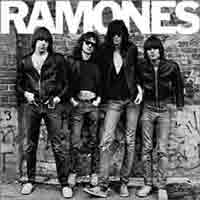 Ein grandioses Debüt, das ich leider erst viel, viel später
zu schätzen gelernt habe!
Ein grandioses Debüt, das ich leider erst viel, viel später
zu schätzen gelernt habe!

 Mehr ...
Mehr ...
|
"Our early songs came out of our real feelings of
alienation, isolation, frustration -- the feelings everybody feels between
seventeen and seventy-five," said singer Joey Ramone. Clocking in
at just under twenty-nine minutes, Ramones is an intense blast of guitar
power, rhythmic simplicity and ferocious brevity, a complete rejection
of the spangled artifice and hollow, artsy pretensions of 1970s rock.
The songs were fast and anti-social, just like the band: "Beat on
the Brat," "Blitzkrieg Bop," "Now I Wanna Sniff Some
Glue." Guitarist Johnny Ramone refused to play solos -- his jackhammer
chords became the lingua franca of punk -- and the whole record cost just
over $600 to make. But Joey's leather-tender plea "I Wanna Be Your
Boyfriend" showed that even punks need love. (Rolling Stone)
Total album sales: Under 500,000, Peak chart position: 111
|
|
| Terry Reid: "Seed Of A Memory" (ABC, Mai 1976) |
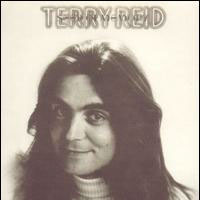 Reids zweites amerikanisches Album habe ich, wie viele andere, damals
aus der Grabbelkiste gezogen. Produziert hatte Graham Nash, der
auch für den Chorgesang sorgt und eine leichte, aber nicht unangenehme
Countryfärbung in viele der Lieder bringt (es spielen u. a. David
Lindley, Ben Keith und Al Perkins). Dazu gibt es in
einigen Titeln klasse Bläsersätze. "Fooling You" ist
mein Lieblingslied von der Platte, eine wunderschöne Ballade mit
Wurlitzer-Piano. Da kein Pianist in den Credits aufgeführt wird,
wahrscheinlich sogar von Reid selbst gespielt. Insgesamt finde ich das
Album viel besser als es manche der damaligen Kritiken formulierten.
Reids zweites amerikanisches Album habe ich, wie viele andere, damals
aus der Grabbelkiste gezogen. Produziert hatte Graham Nash, der
auch für den Chorgesang sorgt und eine leichte, aber nicht unangenehme
Countryfärbung in viele der Lieder bringt (es spielen u. a. David
Lindley, Ben Keith und Al Perkins). Dazu gibt es in
einigen Titeln klasse Bläsersätze. "Fooling You" ist
mein Lieblingslied von der Platte, eine wunderschöne Ballade mit
Wurlitzer-Piano. Da kein Pianist in den Credits aufgeführt wird,
wahrscheinlich sogar von Reid selbst gespielt. Insgesamt finde ich das
Album viel besser als es manche der damaligen Kritiken formulierten.

 Mehr ...
Mehr ...
|
Terry Reid moved to California in the mid-1970s, befriending a number
of musicians from those parts and broadening his sound in the process.
One result was this album, produced by Graham Nash and featuring David
Lindley on acoustic and slide guitars. Seed of Memory isn't as heavy as
his earlier work, and not remotely the bold, strident virtuoso rock production
of his first LP -- most of it, apart from the vaguely Led Zeppelin-ish
"The Way You Walk," is fairly laid-back by Reid's standards.
"Ooh Baby" tries for a kind of meld of funk and British blues.
But several numbers, like "Brave Awakening," with its relaxed
beat, high harmonies, and understated backing orchestration, or the ominous
acoustic-textured "To Be Treated Rite," seem more like outtakes
from Nash's Songs for Beginners or his subsequent albums, or one of Neil
Young's mid-'70s albums, than they do like the work of one of England's
most promising '60s bluesmen. The album ends on an ambitious but disjointed
note, with the ambitious but not wholly successful "Fooling You,"
which makes extensive use of the saxophone. It all just might not be what
fans look for in Reid's work, and lacks some of the excitement of his
other albums.
(by Bruce Eder, All
Music Guide)
|
|
| The Rolling Stones: "Black And Blue" (Rolling Stones Rec., Mai 1987) |
|
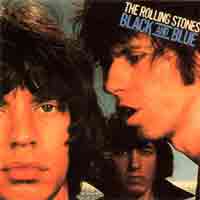 Wie kommt der Kerl hier jetzt nur auf dieses schlappe Stones-Album? Es gibt doch so viele bessere!
Wie kommt der Kerl hier jetzt nur auf dieses schlappe Stones-Album? Es gibt doch so viele bessere!
Das mag ja sein. Immerhin war das Album #1 in den US-Charts und #2
in den britischen Charts! Bevor jetzt irgendein Schlaumeier fragt, seit
wann Herrn Mann sowas interessiert, hier mein wahres Argument für
die Platte: Für mich macht sich das Mögen von Alben oft an
einzelnen Liedern fest, die mich begeistert haben. Hier sind es natürlich
nicht dieses blöde "Hot Stuff", sondern "Memory
Motel" mit Keith Richard am E-Piano, sowie "Melody"
mit einem Gastauftritt von Billy Preston. Als ich mir vor langen
Jahren mal selber ein altes Wurlitzer-Piano gekauft habe und nach schönen
und für Nicht-Piano-Spieler bewältigbaren Stücken gesucht
habe, kam ich dann schnell auf "Memory Motel", denn Keev gilt
nicht an der Gitarre und erst recht nicht am Klavier als Mann der technischen
Kabinettstückchen - und es klingt (trotzdem?) klasse. Witzigerweise
war meine 2. Pianonummer dann "Fooling You" von Terry Reid,
auch ein eher "untechnischer" Gitarrist mit gelegentlichen
Ausflügen ans Piano, von dessen zeitgleich erschienenem Album "Seed
Of Memory"!
|
| "Warren Zevon" (Elektra/Asylum, Juni 1976) |
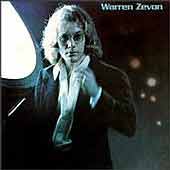 Sein ersten Album für Asylum, quasi sein Debüt (es gibt noch ein
älteres Album von 1970, das ich aber leider nicht kenne). Erste Aufmerksamkeit
bekam er damals, als Linda Ronstadt mehrere seiner
Lieder coverte. Produziert hatte sein Kumpel Jackson Browne, der
die gesamte L.A. Prominenz ins Studio holte (Glenn Frey und Don
Henley von den Eagles, Phil
Everly, Bonnie Raitt, David
Lindley, Stevie Nicks und Lindsey Buckingham von Fleetwood
Mac, etc.), aber die Qualität dieses Albums beruht in erster
Linie auf Mr. Zevon und seinen beeindruckenden Liedern, z.B. "Hasten
Down The Wind", "Carmelita", "Poor, Poor Pitiful Me"
und natürlich "Mohammed's Radio".
Sein ersten Album für Asylum, quasi sein Debüt (es gibt noch ein
älteres Album von 1970, das ich aber leider nicht kenne). Erste Aufmerksamkeit
bekam er damals, als Linda Ronstadt mehrere seiner
Lieder coverte. Produziert hatte sein Kumpel Jackson Browne, der
die gesamte L.A. Prominenz ins Studio holte (Glenn Frey und Don
Henley von den Eagles, Phil
Everly, Bonnie Raitt, David
Lindley, Stevie Nicks und Lindsey Buckingham von Fleetwood
Mac, etc.), aber die Qualität dieses Albums beruht in erster
Linie auf Mr. Zevon und seinen beeindruckenden Liedern, z.B. "Hasten
Down The Wind", "Carmelita", "Poor, Poor Pitiful Me"
und natürlich "Mohammed's Radio". |
| Crosby & Nash: "Whistling Down The Wire" (ABC, Juli 1976) |
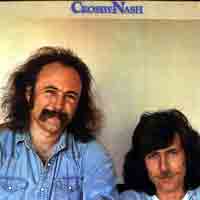 1976 sah es zuerst aus, als würde es eine komplette CSNY Reunion geben.
Dann gab's aber doch "nur" zwei Duo-Platten. Während die
alten Streithähne Stephen und Neil sich zur Stills-Young-Band
zusammentaten, lieferten David und Graham eine schöne,
wenn auch etwas leichtgewichtige Westcoastplatte ab, bei der sie von David
Lindley, Danny Kortchmar (g), Craig Doerge (keyb), Tim
Drummond (bg) und Russ Kunkel (dr) begleitet wurden. Obwohl
die Platte teilweise von der Kritik zerrissen wurde, hat sie für
mich eine gewisse Bedeutung als schöne Hintergrundmusik, was durchaus
positiv gemeint ist. Außerdem trägt Mr. Lindley auf dem Rückseitenfoto
so ein schönes T-Shirt von Nasby & Crosh!
1976 sah es zuerst aus, als würde es eine komplette CSNY Reunion geben.
Dann gab's aber doch "nur" zwei Duo-Platten. Während die
alten Streithähne Stephen und Neil sich zur Stills-Young-Band
zusammentaten, lieferten David und Graham eine schöne,
wenn auch etwas leichtgewichtige Westcoastplatte ab, bei der sie von David
Lindley, Danny Kortchmar (g), Craig Doerge (keyb), Tim
Drummond (bg) und Russ Kunkel (dr) begleitet wurden. Obwohl
die Platte teilweise von der Kritik zerrissen wurde, hat sie für
mich eine gewisse Bedeutung als schöne Hintergrundmusik, was durchaus
positiv gemeint ist. Außerdem trägt Mr. Lindley auf dem Rückseitenfoto
so ein schönes T-Shirt von Nasby & Crosh!
Nachtrag: Das mit dem Nasby & Crosh stimmt so leider nicht,
wie ich gerade feststelle, als ich die Platte mal wieder heraushole. Ich muss das wohl
woanders gelesen haben.(03.04.2021)
|
| "Joan Armatrading" (A&M, Aug. 1976) |
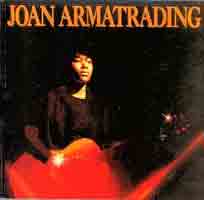 Die aus der Karibik stammende und in England aufgewachsene Sängerin,
Songschreiberin und Gitarristin kam mit dieser dritten Platte (ihrer zweiten
für A&M) groß raus. Ungewöhnlich war für viele, dass
eine farbige Sängerin mit Akustikgitarre auftrat und eher nach Joni
Mitchell und Folk als nach Motown klang. Produziert hatte Glyn Johns,
in der Begleitband spielten u. a. Dave Mattacks (dr) und Jerry
Donahue (g) von meinen Folkrock-Helden Fairport
Convention. Letzterer spielt bei "Tall In The Saddle" eines
seiner besten Gitarrensoli - um Klassen interessanter und somit auch besser
als alles, was er mit den Hellcasters auf eigene Rechnung veröffentlicht
hat.
Die aus der Karibik stammende und in England aufgewachsene Sängerin,
Songschreiberin und Gitarristin kam mit dieser dritten Platte (ihrer zweiten
für A&M) groß raus. Ungewöhnlich war für viele, dass
eine farbige Sängerin mit Akustikgitarre auftrat und eher nach Joni
Mitchell und Folk als nach Motown klang. Produziert hatte Glyn Johns,
in der Begleitband spielten u. a. Dave Mattacks (dr) und Jerry
Donahue (g) von meinen Folkrock-Helden Fairport
Convention. Letzterer spielt bei "Tall In The Saddle" eines
seiner besten Gitarrensoli - um Klassen interessanter und somit auch besser
als alles, was er mit den Hellcasters auf eigene Rechnung veröffentlicht
hat.

 Mehr ...
Mehr ...
|
Joan Armatrading's eponymous third album is a charmer, almost single-handedly
elevating her into the ranks of rock's leading female artists. Up to this
point, Armatrading had shown that she had a lovely voice and an ear for
interesting arrangements, but her work had been steeped in the folk idiom
of the early '70s. Her third album changed all that, with producer Glyn
Johns bringing in members of Gallagher & Lyle, Fairport Convention,
and the Faces to punch up her folksy sound with elements of rock, country,
and disco. The result is her most muscular music to date, with Armatrading
adopting a swagger that showed her tales of unluckiness in love didn't
have to have dire consequences ("Tall in the Saddle," "Water
With the Wine"). Of course, it helped that the record featured her
best material delivered in a wonderfully expressive voice that can capture
the shades between song and speech like a sweeter version of Ian Anderson.
"Down to Zero" (which features pedal steel guitarist B.J. Cole)
and "Love and Affection" are the album's most memorable tracks,
the latter breaking into the U.K.'s Top Ten (the album itself made the
U.K. Top 20). But what endears this record to fans is the quality of each
song; it wouldn't be fair to call anything here filler. The artsy and
eclectic "Like Fire," the beautiful ballad "Save Me,"
and the ingratiating melodies of "Somebody Who Loves You" are
just as likely to strike a chord with listeners as the better-known cuts.
While Glyn Johns deserves credit for bringing Joan Armatrading's songs
into a more flattering setting -- it's not coincidental that the record
feels like a polished version of The Who by Numbers -- his real stroke
of genius was letting the artist flower to her full potential. For many,
this album remains the high point in her catalog.
(by Dave Connolly, All
Music Guide)
|
|
| Hawkwind: "Astounding Sounds And Amazing Music" (Charisma, Aug. 1976) |
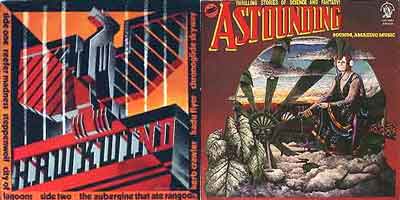 Das letzte Album aus der ersten Phase meiner (zu dem Zeitpunkt ehemaligen)
Lieblinxband, das ich mir damals direkt gekauft hatte. Und auch eigentlich
nur deshalb, weil ich die Band erstmalig live erlebt hatte (Doppelkonzert
mit Van Der Graaf in der Essener PH!). Was kann
man zur Musik sagen? Dave Brock hält wie immer alles zusammen.
Saxmann Nik Turner war (leider!) zum letzten mal dabei, Sänger/Poet
Bob Calvert war zurückgekehrt,
Ex-Pink Fairies-Gitarrist Paul
Rudolph hatte Lemmy am Bass abgelöst. Der Sound war inzwischen
etwas weniger schräg, einmal gibt es sogar einen leichten Latin-Einschlag.
Nicht lachen: bei "Steppenwolf" klingt die Perkussion (Timbales
und eine Gurke) tatsächlich nach Santana! Und es gibt sogar
eine deutsche Textzeile: "und isch weiß nischt was isch sagen
soll". Was auch immer uns das sagen soll. Beim Nachfolgealbum
"Quark, Strangeness And Charm"
hatte ich dann (vorerst) aufgegeben. Damals fand ich die "Astounding
Sounds" eigentlich ziemlich furchtbar - heute dagegen gefällt es
mit sogar richtig gut!
Das letzte Album aus der ersten Phase meiner (zu dem Zeitpunkt ehemaligen)
Lieblinxband, das ich mir damals direkt gekauft hatte. Und auch eigentlich
nur deshalb, weil ich die Band erstmalig live erlebt hatte (Doppelkonzert
mit Van Der Graaf in der Essener PH!). Was kann
man zur Musik sagen? Dave Brock hält wie immer alles zusammen.
Saxmann Nik Turner war (leider!) zum letzten mal dabei, Sänger/Poet
Bob Calvert war zurückgekehrt,
Ex-Pink Fairies-Gitarrist Paul
Rudolph hatte Lemmy am Bass abgelöst. Der Sound war inzwischen
etwas weniger schräg, einmal gibt es sogar einen leichten Latin-Einschlag.
Nicht lachen: bei "Steppenwolf" klingt die Perkussion (Timbales
und eine Gurke) tatsächlich nach Santana! Und es gibt sogar
eine deutsche Textzeile: "und isch weiß nischt was isch sagen
soll". Was auch immer uns das sagen soll. Beim Nachfolgealbum
"Quark, Strangeness And Charm"
hatte ich dann (vorerst) aufgegeben. Damals fand ich die "Astounding
Sounds" eigentlich ziemlich furchtbar - heute dagegen gefällt es
mit sogar richtig gut! |
| Linda Ronstadt: "Hasten Down The Wind" (Elektra/Asylum, Aug. 1976) |
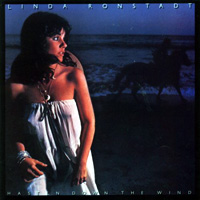 Mitte der 70er war Linda Ronstadt eine der erfolgreichsten "Rock"-Sängerinnen
überhaupt. Ich habe von ihren Alben aus dieser Zeit "Hasten
Down The Wind" vor allem wegen der vorzüglich Songs (und natürlich
nicht wegen des Coverfotos!) ausgewählt. Zum ersten Mal stand die
Songschreiberin Karla Bonoff im Blickpunkt
(3 Songs auf dieser Platte!), weiterhin Lieder von Warren
Zevon (der Titelsong), "Crazy" von Willie Nelson
(Patsy Clines größter Hit) und sogar eine von Lindas
seltenen Eigenkompositionen ("Try Me Again"). Die Begleitung
wird zum größten Teil von Andrew Gold und Kenny Edwards
bestritten.
Mitte der 70er war Linda Ronstadt eine der erfolgreichsten "Rock"-Sängerinnen
überhaupt. Ich habe von ihren Alben aus dieser Zeit "Hasten
Down The Wind" vor allem wegen der vorzüglich Songs (und natürlich
nicht wegen des Coverfotos!) ausgewählt. Zum ersten Mal stand die
Songschreiberin Karla Bonoff im Blickpunkt
(3 Songs auf dieser Platte!), weiterhin Lieder von Warren
Zevon (der Titelsong), "Crazy" von Willie Nelson
(Patsy Clines größter Hit) und sogar eine von Lindas
seltenen Eigenkompositionen ("Try Me Again"). Die Begleitung
wird zum größten Teil von Andrew Gold und Kenny Edwards
bestritten. |
| The Stills-Young Band: "Long May You Run" (Reprise, Aug. 1976) |
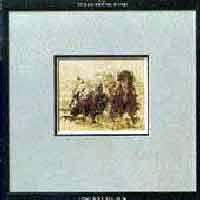 Hier prallten die beiden Streithähne Stephen Stills und Neil
Young nach Buffalo Springfield (1966-68)
und CSN&Y (1970/71) erstmalig
wieder aufeinander, machten eine schöne Platte und verkrachten sich
bei der anschließenden Tournee wieder, sodass Stills im Folgejahr
wieder bei Crosby & Nash landete (eine andere
Geschichte!). Wir hören sehr gute (das Titelstück und der Rocker
"Fountainebleau") und mittelgute Stücke von Neil, während
Stills nach meiner Meinung hier zu vorletzten mal ("CSN"
1977 wird dann noch ganz gut!) in seiner Karriere gute Songs ablieferte,
z.B. "Make Love To You" mit einer tollen Orgel). Die Begleitmusiker
stammen aus dem Stills-Umfeld: Joe Lala (perc), George Perry
(bg), Joe Vitale (Schlagzeug und Querflöte!) und Jerry
Aiello (Orgel).
Hier prallten die beiden Streithähne Stephen Stills und Neil
Young nach Buffalo Springfield (1966-68)
und CSN&Y (1970/71) erstmalig
wieder aufeinander, machten eine schöne Platte und verkrachten sich
bei der anschließenden Tournee wieder, sodass Stills im Folgejahr
wieder bei Crosby & Nash landete (eine andere
Geschichte!). Wir hören sehr gute (das Titelstück und der Rocker
"Fountainebleau") und mittelgute Stücke von Neil, während
Stills nach meiner Meinung hier zu vorletzten mal ("CSN"
1977 wird dann noch ganz gut!) in seiner Karriere gute Songs ablieferte,
z.B. "Make Love To You" mit einer tollen Orgel). Die Begleitmusiker
stammen aus dem Stills-Umfeld: Joe Lala (perc), George Perry
(bg), Joe Vitale (Schlagzeug und Querflöte!) und Jerry
Aiello (Orgel). |
| Steve Young: "Renegade Picker" (RCA, Aug. 1976) |
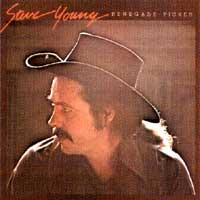 Steve Young kann man mit seinem Debüt "Rock, Salt & Nails" von 1969 neben
Gram Parsons, Gene Clark
und wenigen anderen zurecht als einen der Pioniere des Countryrocks
bezeichnen. Wie bei so vielen Singer/Songwritern war er mit seinen eigenen
Versionen leider nie so erfolgreich wie andere Leute, die seine Lieder
aufnahmen, z.B. die Eagles mit
"Seven Bridges Road" oder Waylon Jennings mit "Lonesome,
On'ry & Mean", letzteres ist dann auch hier in einer eigenen
Neuaufnahme zu hören. Was kann man zu dieser sehr guten, aber (natürlich
relativ) erfolglosen Platte sagen? RCA gab ihm nach Waylons Erfolg mit
"Lonesome..." eine Chance zur Nashville-Produktion mit großem
Budget. Trotz der Edelbegleiter aus Nashville fällt vor allem seine
gute und kraftvolle Stimme und sein gutes eigenes Gitarrenspiel auf. Neben
eigenen guten Songs gibt es (wie so oft bei Steve Young) Coverversionen
von Liedern der Kollegen in Augenhöhe zu hören: Dieses mal sind
es Lieder von Merle Haggard, Willie Nelson, Guy Clark
und Rodney Crowell. Ein Konzertklassiker bei Young wurde dann aber
vor allem das eigentlich schon ziemlich oft gehörte "Tobacco
Road" von John D. Loudermilk.
Steve Young kann man mit seinem Debüt "Rock, Salt & Nails" von 1969 neben
Gram Parsons, Gene Clark
und wenigen anderen zurecht als einen der Pioniere des Countryrocks
bezeichnen. Wie bei so vielen Singer/Songwritern war er mit seinen eigenen
Versionen leider nie so erfolgreich wie andere Leute, die seine Lieder
aufnahmen, z.B. die Eagles mit
"Seven Bridges Road" oder Waylon Jennings mit "Lonesome,
On'ry & Mean", letzteres ist dann auch hier in einer eigenen
Neuaufnahme zu hören. Was kann man zu dieser sehr guten, aber (natürlich
relativ) erfolglosen Platte sagen? RCA gab ihm nach Waylons Erfolg mit
"Lonesome..." eine Chance zur Nashville-Produktion mit großem
Budget. Trotz der Edelbegleiter aus Nashville fällt vor allem seine
gute und kraftvolle Stimme und sein gutes eigenes Gitarrenspiel auf. Neben
eigenen guten Songs gibt es (wie so oft bei Steve Young) Coverversionen
von Liedern der Kollegen in Augenhöhe zu hören: Dieses mal sind
es Lieder von Merle Haggard, Willie Nelson, Guy Clark
und Rodney Crowell. Ein Konzertklassiker bei Young wurde dann aber
vor allem das eigentlich schon ziemlich oft gehörte "Tobacco
Road" von John D. Loudermilk.

 Mehr ...
Mehr ...
Renegade Picker, issued in 1976, is the first of a pair recorded for
RCA -- to date, Young's last major-label deal. Renegade Picker and its
compatriot, No Place to Fall, issued two years later, are stellar examples
of outlaw country at its best. Equal parts country, rock, blues, and gospel,
the album is stocked like a trout pond with awesome songs. Young is his
own best coach when it comes to recording material other than his own,
and here he grabs the best. The title track is a stomping, choogling,
cut-time anthem with Buddy Emmons' pedal steel and the popping electrics
of Jerry Chock and Dale Sellers. As if to answer the question as to where
the new hard-driving sound came from, Young follows it up with a moving
cover of Merle Haggard's "I Can't Be Myself," a slow and deliberate
honky tonk number full of restless country-soul. Side one's highlight
is a rollicking version of J.D. Loudermilk's "Tobacco Road"
driven by bluesed-out acoustic guitars, stomping feet, and Terry McMillan's
harmonica. If side one is a primer on Young's country heritage and outlaw
lineage, side two is his statement of purpose. The first cut is a re-recording
of "Lonesome, On'ry, and Mean," with a full-on band burning
at the edges of his vocal. Buddy Emmons' steel drives the entire track
just atop the drums. But it's Young's version of Guy Clark's "Broken
Hearted People (Take Me to a Barroom)" with Tracy Nelson's backing
vocals that brings the essence of the fissure between the tradition and
new breed home. His reading of the song is more country than Clark's folky
one, but Young can hear Hank Williams and Billy Joe Shaver in Clark's
lyric; he holds the tension between the two inside the grain of his voice.
Renegade Picker and No Place to Fall have been reissued as a double-CD
package on BMG in Europe, completely remastered for a budget price. No
matter how you get these records, just get them. They sound as relevant
as they did 25 years ago.
(by Thom Jurek, AMG)
|
| Bob Dylan: "Hard Rain" (Columbia, Sept. 1976) |
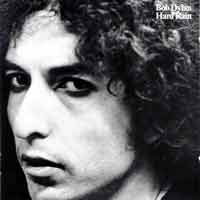 Ein richtig gutes Livealbum des Meisters, sogar besser als "Before The
Flood" von 1974, das er immerhin mit "The Band" eingespielt
hatte. Aber auch hier ist um die drei Musiker der Alpha Band (T-Bone
Burnett, David Mansfield und Steven Soles) eine klasse
Truppe versammelt, erwähnenswert vor allem noch die Geigerin mit
dem tollen Namen: Scarlet Rivera.
Ein richtig gutes Livealbum des Meisters, sogar besser als "Before The
Flood" von 1974, das er immerhin mit "The Band" eingespielt
hatte. Aber auch hier ist um die drei Musiker der Alpha Band (T-Bone
Burnett, David Mansfield und Steven Soles) eine klasse
Truppe versammelt, erwähnenswert vor allem noch die Geigerin mit
dem tollen Namen: Scarlet Rivera. |
| Ry Cooder: "Chicken Skin Music" (Reprise, Okt. 1976) |
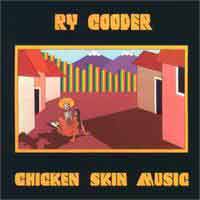

 Mehr ...
Mehr ...
Dieses 1976er Unternehmen enthält einige von Cooders bezwingendsten Arbeiten. Er erforscht hier erneut einige der grundlegenden Einflüsse auf einen Musiker, der für seinen bemerkenswerten Eklektizismus bekannt ist. Höchst bemerkenswert sind "Always Lift Him Up", "Smack Dab In The Middle" und eine schöne Adaption von "Stand By Me" mit Flaco Jimenez am Akkordeon. Das Album beginnt und endet mit Leadbelly-Coverversionen: "The Bourgeois Blues" und (Sie haben es erraten) "Goodnight Irene". Ebenso bemerkenswert ist eine feine Überarbeitung des Traditionals "I Got Mine".
(Wayne Pernu, amazon)
Ry Cooders "Gänsehautmusik" von 1976 enthält die vermutlich
originellsten Versionen zweier großer Pophits - Jim Reeves' "He'll
Have To Go" und Ben E. Kings "Stand By Me". Flaco Jimenez'
Akkordeon verleiht ein Cajun- beziehungsweise Tex-Mex-Aroma. Für zwei
Titel bat Ry Cooder die hawaiianischen Gitarristen Gabby Pahinui und Atta
Isaacs ins Studio und kreierte eine wunderbare authentische Aloha-Sentimentalität.
Französisch-Louisiana läßt schön grüßen in
den Leadbelly-Songs "The Bourgeois Blues" und "Goodnight Irene".
Gospel und Rhythm & Blues ("I Got Min", "Always Lift Him
Up", "Smack Dab In The Middle") runden das stilistische Spektrum
die- ses auch klangtechnisch makellosen Albums ab.
(© Stereoplay)
|
| Joni Mitchell: "Hejira" (Elektra/Asylum, Okt. 1976) |
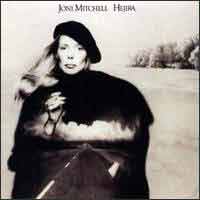 Meine Lieblingsplatte von Joni, vor allem wegen des Songs "Coyote".
Der Sound ist sehr jazzig, Begleiter: Larry Carlton (g), Jaco Pastorius (bg) u.a.
Meine Lieblingsplatte von Joni, vor allem wegen des Songs "Coyote".
Der Sound ist sehr jazzig, Begleiter: Larry Carlton (g), Jaco Pastorius (bg) u.a.

 Mehr ...
Mehr ...
After the expanded instrumental scale and sonic experimentation of Court and Spark and The Hissing of Summer Lawns, Joni Mitchell reverses that flow for the more intimate, interior music on Hejira, which retracts the arranging style to focus on Mitchell's distinctive acoustic guitar and piano, and the brilliant, lyrical bass fantasias of fretless bass innovator Jaco Pastorius. Known for his furious, sometimes rococo figures beneath the music of Weather Report, Pastorius is tamed by Mitchell's cooler, more deliberate ballads; these meditations coax a far gentler, subdued lyricism from Pastorius, whose intricate bass counterpoints Mitchell's coolly elegant singing, especially on the sublime "Amelia," which transforms the mystery of Amelia Earhart into a parable of both feminism and romantic self-discovery. This isn't Mitchell at her most obviously ambitious, yet the depth of feeling, poetic reach and musical confidence make this among the finest works in a very fine canon.
(Sam Sutherland)
|
| Graham Parker & The Rumour: "Heat Treatment" (Vertigo, Okt. 1976) |
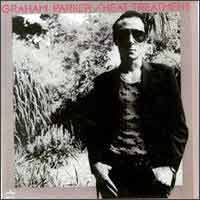 6 Monate nach "Howlin' Wind" das nächste
Klassealbum des britischen Singer/Songwriters. The Rumour spielen auch
wieder in Höchstform. Eine der ersten Produktionen von Robert "Mutt"
Lange, der danach Dank Kunden wie AC/DC, Def Leppard und
Shania Twain in die erste Liga aufstieg. Anders als Mister Parker.
6 Monate nach "Howlin' Wind" das nächste
Klassealbum des britischen Singer/Songwriters. The Rumour spielen auch
wieder in Höchstform. Eine der ersten Produktionen von Robert "Mutt"
Lange, der danach Dank Kunden wie AC/DC, Def Leppard und
Shania Twain in die erste Liga aufstieg. Anders als Mister Parker. |
| Bob Seger: "Night Moves" (Capitol, Okt. 1976) |
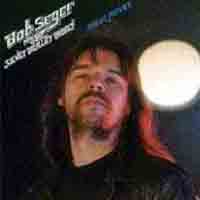 Damals ein gigantischer Platin-Erfolg für Seger und seine "Silver Bullit
Band". Selten sind Platten wie diese, bei denen sich Kritik und zahlendes
Publikum einmal einig sind!
Damals ein gigantischer Platin-Erfolg für Seger und seine "Silver Bullit
Band". Selten sind Platten wie diese, bei denen sich Kritik und zahlendes
Publikum einmal einig sind! |
| Patti Smith Group: "Radio Ethiopia" (Arista, Okt. 1976) |
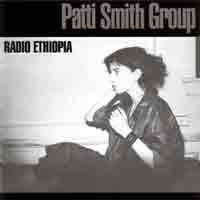 Patti ist ja leider, leider erst eine späte Entdeckung von mir. Eigentlich
habe ich mich erst seit Ende der 80er, also mit dem Comebackalbum "Dream
Of Life", wirklich für ihre Musik interessiert. Und für
"Radio Ethopia" habe ich besonders lange gebraucht. Warum? Vielleicht
weil weder etwas wie "Dancing Barefoot", noch etwas wie "Frederick"
darauf zu finden ist? Jetzt aus der Distanz betrachtet ist das rational
nicht nachzuvollziehen, denn schließlich gibt es auch hier jede Menge
klasse Songs (z.B. der Rocker "Ask The Angels", die Pianoballade(?)
"Pissing In The River", "Poppies" und das 12minütige
"Abyssina") und die Band spielt wirklich gut (Lenny Kaye,
Ivan Kral, J.D. Daugherty und Richard Sohl). Natürlich
nicht "gut" im Sinne von "virtuos", sondern mit einer
beeindruckenden Intensität und Teamleistung - eben "Rock'n'Roll"
wie er sein sollte!
Patti ist ja leider, leider erst eine späte Entdeckung von mir. Eigentlich
habe ich mich erst seit Ende der 80er, also mit dem Comebackalbum "Dream
Of Life", wirklich für ihre Musik interessiert. Und für
"Radio Ethopia" habe ich besonders lange gebraucht. Warum? Vielleicht
weil weder etwas wie "Dancing Barefoot", noch etwas wie "Frederick"
darauf zu finden ist? Jetzt aus der Distanz betrachtet ist das rational
nicht nachzuvollziehen, denn schließlich gibt es auch hier jede Menge
klasse Songs (z.B. der Rocker "Ask The Angels", die Pianoballade(?)
"Pissing In The River", "Poppies" und das 12minütige
"Abyssina") und die Band spielt wirklich gut (Lenny Kaye,
Ivan Kral, J.D. Daugherty und Richard Sohl). Natürlich
nicht "gut" im Sinne von "virtuos", sondern mit einer
beeindruckenden Intensität und Teamleistung - eben "Rock'n'Roll"
wie er sein sollte!

 Mehr ...
Mehr ...
After the success of Horses, Patti Smith had something to prove to reviewers and to the industry, and Radio Ethiopia aimed at both. Producer Jack Douglas gave "the Patti Smith Group," as it was now billed, a hard rock sound, notably on the side-opening "Ask the Angels" and "Pumping (My Heart)," songs that seemed aimed at album-oriented rock radio. But the title track was a ten-minute guitar extravaganza that pushed the group's deliberate primitivism closer to amateurish thrashing. Elsewhere, Smith repeated the reggae excursions and vocal overlaying that had paced Horses on "Ain't It Strange" and "Poppies," but these efforts were less effective than they had been the first time around, perhaps because they were less inspired, perhaps because they were more familiar. A schizophrenic album in which the many elements that had worked so well together on Horses now seemed jarringly incompatible, with Radio Ethiopia Smith and her band encountered the same development problem the punks would � as they learned their craft and competence set in, they lost some of the unself-consciousness that had made their music so appealing.
(by William Ruhlmann, All Music Guide)
|
| Alkatraz: "Doing A Moonlight" (United Artists, Nov. 1976) |
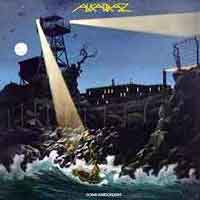 Eine der letzten schönen Hippie-Rockplatten, bevor alles vom Punk
weggefegt wurde. Klingt alles sehr nach meiner walisischen Lieblingsband
Man, was unter anderem daran liegt, dass Sänger und Gitarrist
Will Youatt als Sänger und Bassist bei zwei der schönsten
Man-Alben mit dabei war: "Be Good
To Yourself, At Least Once A Day" von 1972 und "Back
Into The Future" von 1973. Auch die Rhythmusgruppe (Drummer Stuart
Halliday und Bassist Jeff Singer) hat den gleichen Anschlag
wie Terry Williams und Martin Ace von Man drauf. Die Intro
von "Zen Cookies" zitiert ganz ungeniert den Man-Klassiker "Bananas"
und der Rhythmus ist mehrmals ganz deutlich als Man-Shuffle (denkt an
"Romain" oder "Life On The Road") zu identifizieren.
Als Gastkeyboarder hört man - überraschung! - Ex-Man
Clive John.
Eine der letzten schönen Hippie-Rockplatten, bevor alles vom Punk
weggefegt wurde. Klingt alles sehr nach meiner walisischen Lieblingsband
Man, was unter anderem daran liegt, dass Sänger und Gitarrist
Will Youatt als Sänger und Bassist bei zwei der schönsten
Man-Alben mit dabei war: "Be Good
To Yourself, At Least Once A Day" von 1972 und "Back
Into The Future" von 1973. Auch die Rhythmusgruppe (Drummer Stuart
Halliday und Bassist Jeff Singer) hat den gleichen Anschlag
wie Terry Williams und Martin Ace von Man drauf. Die Intro
von "Zen Cookies" zitiert ganz ungeniert den Man-Klassiker "Bananas"
und der Rhythmus ist mehrmals ganz deutlich als Man-Shuffle (denkt an
"Romain" oder "Life On The Road") zu identifizieren.
Als Gastkeyboarder hört man - überraschung! - Ex-Man
Clive John.
Gesamturteil: ein Muss für Man-Fans, aber kein bloßes Plagiat,
sondern eher gemeinsame walisische Wurzeln. Vom Chorgesang her vielleicht
sogar einen "Tacken" besser als das "Original".

 Mehr ...
Mehr ...
|
"Alkatraz's only LP was released in November 1976
having been recorded at Rockfield Studios during September that year.
'Doing A Moonlight' showed Alkatraz to be a highly commercial act, the
album was full of good songs and great guitar playing. Will Youtt was
joined by former Quicksand bandmate James Davies on guitar and Stuart
Halliday from the Neutrons on drums. Bass player Jeff Singer had also
appeared on an early Neutrons session. Their uptempo, good-time music
proved very popular with audiences of the time Alkatraz were a busy gigging
band right from the start. Although their tour schedule kept them on the
road throughout the next twelve months, audience appreciation didn't convert
into album sales, and the band were swept away in the Punk revolution."
(von einer Man-Fanseite)
|
|
| Jackson Browne: "The Pretender" (Elektra/Asylum, Nov. 1976) |
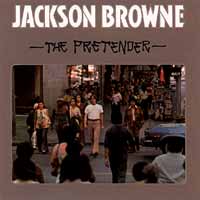 Damals das erste Jackson Browne-Album, dass ich nicht auf Anhieb mochte
- aber inzwischen weiß ich es doch zu schätzen!
Damals das erste Jackson Browne-Album, dass ich nicht auf Anhieb mochte
- aber inzwischen weiß ich es doch zu schätzen!
(27.04.2013)

 Mehr ...
Mehr ...
|
On The Pretender, Jackson Browne took a step back from the precipice
so well defined on his first three albums, but doing so didn't seem to
make him feel any better. Employing a real producer, Jon Landau, for the
first time, Browne made what sounded like a real contemporary rock record,
but this made his songs less effective; the ersatz Mexican arrangement
of "Linda Paloma" and the bouncy second half of "Daddy's
Tune," with its horn charts and guitar solo, undercut the lyrics.
The man who had delved so deeply into life's abyss on his earlier albums
was in search of escape this time around, whether by crying ("Here
Come Those Tears Again"), sleeping ("Sleep's Dark and Silent
Gate"), or making peace with estranged love ones ("The Only
Child," "Daddy's Tune"). None of it worked, however, and
when Browne came to the final track -- traditionally the place on his
albums where he summed up his current philosophical stance -- he delivered
"The Pretender," a cynical, sarcastic treatise on moneygrubbing
and the shallow life of the suburbs. Primarily inner-directed, the song's
defeatist tone demands rejection, but it is also a quintessential statement
of its time, the post-Watergate '70s; dire as that might be, you had to
admire that kind of honesty, even as it made you wince.
(by William Ruhlmann, All
Music Guide)
|
|
| Tom Petty & The Heartbreakers (Shelter, Nov. 1976) |
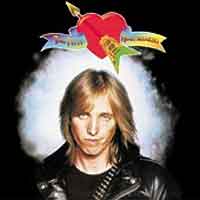 Das gelungene Debüt. Ich bin kein besonderer Petty-Fan, fand aber die
Energie dieser ersten Platte immer sehr überzeugend.
Das gelungene Debüt. Ich bin kein besonderer Petty-Fan, fand aber die
Energie dieser ersten Platte immer sehr überzeugend.
|
| Ougenweide: "Eulenspiegel" (Polydor, Dez. 1976) |
|
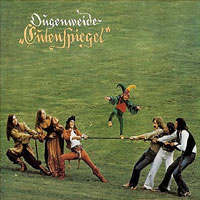 1976 hatte die Band wohl wirklich "einen Lauf" mit gleich zwei
Alben - aber es liegen ja doch immerhin 11 Monate zwischen "Ohrenschmaus"
und "Eulenspiegel", das in musikalischer Hinsicht vielleicht
nochmal eine Steigerung bedeutet, aber auf jeden Fall die hohe Qualität
behält.
1976 hatte die Band wohl wirklich "einen Lauf" mit gleich zwei
Alben - aber es liegen ja doch immerhin 11 Monate zwischen "Ohrenschmaus"
und "Eulenspiegel", das in musikalischer Hinsicht vielleicht
nochmal eine Steigerung bedeutet, aber auf jeden Fall die hohe Qualität
behält.
Auch der "Kulturbetrieb" hatte die Band entdeckt: Seite 1
der LP besteht aus 5 Liedern für eine Stuttgarter Theaterproduktion
zum Thema Till Eulenspiegel, während Seite 2 die bewährten
Ougenweide-Stilmittel einsetzt: alte Texte mit neuer Musik auf alten
und neuen Instrumenten.
Besonders angetan hatten es mir damals die letzten drei Lieder der Platte:
Zuerst "Wol Mich Der Stunde" mit dem poetischen
Text von Walther von der Vogelweide, gesungen von Olaf Casalich,
das in einen Improvisationsteil in bester Canterbury-Manier getragen
von Stefan Wulffs Basslauf übergeht, über das Gitarrist
Wolfgang von Henko und Multiinstrumentalist Frank Wulff
am Krummhorn, das ganz wunderbar wie eine billige E-Gitarre am billigen
Fuzz-Effektgerät klingt, einfache aber schöne Improvisationen
spielen. Danach "Durch Den Ermel Gat Daz Loch",
das mit Engelsgesang von Minne Graw beginnt und sich immer weiter
steigert, u.a. mit einem Querflötensolo, das sich nicht hinter
Jethro Tull verstecken muss und Frank Wulff locker in
die Spielklasse von Tijs van Leer (Focus) bringt, um schließlich
in einem Kanon zu enden, noch bevor es ein rätselhaftes Fade auf
der E-Gitarre gibt, das mich auch nach 30 Jahren Hörunterbrechung
noch immer angenehm verwirrt. Zum Schluss folgt mit "Enzio"
ein schöne Ballade mit schönem E-Piano (hallo: es müssen
nicht immer "historische" Instrumente sein!)
(17.07.2010)
|
| Amazing Rhythm Aces: "Too Stuffed To Jump" (ABC, 1976) |
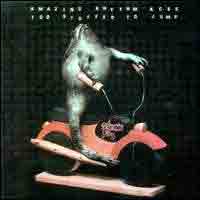 Auch auf ihrem zweiten Album bringen die "erstaunlichen Rhythmus
Asse" wieder ihre tolle Mischung aus Rock, Rhythm'n'Blues und Country.
Auch auf ihrem zweiten Album bringen die "erstaunlichen Rhythmus
Asse" wieder ihre tolle Mischung aus Rock, Rhythm'n'Blues und Country.

 Mehr ...
Mehr ...
|
"One of the best country soul/southern rock crossover bands, the
Aces featured the vocal talents of Russell Smith (as distinctive a voice
as you could ever hope for) and pianist James Hooker (who later became
Nanci Griffith's bandleader and arranger). Although they have more than
their fair share of super-goofy '70s moments, they also had plenty of
solid, fabulously well-produced tunes. Their big Top 40 hit was "Third
Rate Romance," with a singalong chorus that's still as catchy today
as it was in '75. But there are plenty of other goodies in their catalog,
particularly "Typical American Boy," one of the great dopey
redneck ballads of all time."
|
|
| "American Flyer" (United Artists, 1976) |
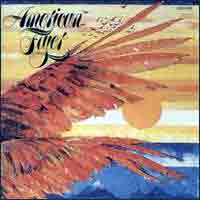 Eine interessante, aber völlig unbekannt gebliebene Formation aus dieser
Zeit! Singer/Songwriter-Countryrock im Fahrwasser von Crosby, Stills,
Nash & Young, aber aufgrund der hohen Qualität der beteiligten
Musiker auf jeden Fall eine interessante Fußnote in der Rock-Historie.
Craig Fuller war mal bei den Countryrockern Pure Prairie League,
aus deren Reihen ürigenz auch Vince Gill stammt, und hat in
den 80ern bei den reformierten Little
Feat den Platz von Lowell George eingenommen. Eric Kaz
ist ein Singer/Songwriter, der immerhin einige hochklassige Songs für
Linda Ronstadt und Bonnie Raitt verfasst hat. Das für
Bonnie Raitt geschriebene "Love Has No Pride" (vom Album
"Give It Up") wird hier sogar in einer eigenen Version gebracht.
Steve Katz war sogar Gründungsmitglied von zwei legendären Bands
(The Blues Project und Blood,
Sweat & Tears) und produzierte Lou Reed's erfolgreiches
Livealbum "Rock'n'Roll Animal". Doug Yule war der (von
orthodoxen Fans geschmähte) Nachfolger von John Cale bei den
Velvet Underground. Alle vier singen,
spielen Gitarre und Keyboards und werden von einer illustren Gästeschar
unterstützt, u. a.: Larry Carlton, Rusty Young, Leland
Sklar, Joe Sample und Ernie Watts. Produziert hat niemand
Geringerer als Sir George Martin. Die Band trat, soweit ich weiß,
nie live auf und flog nach 2 Alben aus ihrem Plattenvertrag wieder raus.
c'est la vie!
Eine interessante, aber völlig unbekannt gebliebene Formation aus dieser
Zeit! Singer/Songwriter-Countryrock im Fahrwasser von Crosby, Stills,
Nash & Young, aber aufgrund der hohen Qualität der beteiligten
Musiker auf jeden Fall eine interessante Fußnote in der Rock-Historie.
Craig Fuller war mal bei den Countryrockern Pure Prairie League,
aus deren Reihen ürigenz auch Vince Gill stammt, und hat in
den 80ern bei den reformierten Little
Feat den Platz von Lowell George eingenommen. Eric Kaz
ist ein Singer/Songwriter, der immerhin einige hochklassige Songs für
Linda Ronstadt und Bonnie Raitt verfasst hat. Das für
Bonnie Raitt geschriebene "Love Has No Pride" (vom Album
"Give It Up") wird hier sogar in einer eigenen Version gebracht.
Steve Katz war sogar Gründungsmitglied von zwei legendären Bands
(The Blues Project und Blood,
Sweat & Tears) und produzierte Lou Reed's erfolgreiches
Livealbum "Rock'n'Roll Animal". Doug Yule war der (von
orthodoxen Fans geschmähte) Nachfolger von John Cale bei den
Velvet Underground. Alle vier singen,
spielen Gitarre und Keyboards und werden von einer illustren Gästeschar
unterstützt, u. a.: Larry Carlton, Rusty Young, Leland
Sklar, Joe Sample und Ernie Watts. Produziert hat niemand
Geringerer als Sir George Martin. Die Band trat, soweit ich weiß,
nie live auf und flog nach 2 Alben aus ihrem Plattenvertrag wieder raus.
c'est la vie! |
| "Peter Bursch und die Bröselmaschine" (Intercord/Xenophon, 1976) |
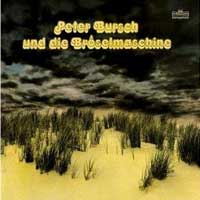 Gefunden in der Grabbelkiste!
Gefunden in der Grabbelkiste!
(17.12.2006)
|
| Gary Burton Quintet: "Dreams So Real" (ECM, 1976) |
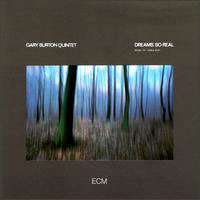 Mit Neuzugang Pat Metheny, der hier zusammen
mit seinem ehemaligen Gitarrenlehrer Mick
Goodrick einen wunderbaren Gitarrenklangteppich webt, wurde aus dem
Gary Burton Quartett ein Quintett. Alle Kompositionen stammen
von Carla Bley.
Mit Neuzugang Pat Metheny, der hier zusammen
mit seinem ehemaligen Gitarrenlehrer Mick
Goodrick einen wunderbaren Gitarrenklangteppich webt, wurde aus dem
Gary Burton Quartett ein Quintett. Alle Kompositionen stammen
von Carla Bley.

 Mehr ...
Mehr ...
Performing the intricate music of Carla Bley is no mean feat, but if anyone is up for the challenge, it would be vibraphonist Gary Burton. Signifying a high watermark in his career in the mid-'70s, Dreams So Real teams Burton with his fellow professor at the Berklee College of Music Mick Goodrick, along with recently graduated student Pat Metheny. Add the peerless electric bass guitarist Steve Swallow and always proficient drummer Bob Moses, and you have the makings of a short-lived supergroup capable of playing Bley's memorable, melancholy music. While generally regarded as one of many Burton/Metheny pairings, it is Goodrick's individualism (it was he who primarily tutored Metheny) that needs more recognition. With Goodrick on electric six-string and Metheny on electric 12-string guitar, the sonorities they establish allow Burton to freely discourse on Bley's prickly angular melodies. The brittle and fractured combo track "Ictus/Syndrome" � closer to a three-piece suite � goes from a frantic neo-bop meter to straight-ahead swing with a clearly inspired Burton rambling into the bright signature rondo sound that Metheny and Swallow have always owned. "Syndrome" might also be familiar to Bley's fans as "Wrong Key Donkey." "Doctor" merges the vibes and guitars into a guided prognosis of hypertension within slowly elevated blood pressure levels. "Intermission Music," inspired by golden age films, is a beautiful waltz vehicle for the guitars rhythmically, and for Swallow and Moses melodically. With the bandmembers at their most passionate, the title track is a lighthearted but cerebral ballad, "Vox Humana" a simplified tango, while "Jesus Maria" evokes the delicate epic strains of Bley's personalized sound with Burton playing it alone. While the singing sound of Metheny is in its infant stages, it is easily recognizable and clearly realized. Generally regarded as one of Burton's top three recorded dates, it has stood the test of time. Perhaps some day, a complete collection of the vibist playing Carla Bley's many other compositions can be compiled to complement this surface-scratching but very important album.
(by Michael G. Nastos, All Music Guide)
|
| Harry Chapin: "On The Road To Kingdom Come" (Elektra, 1976) |
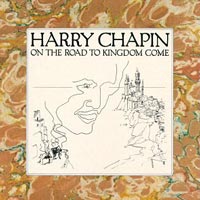 Einer der besten amerikanischen Geschichtenerzähler und leider viel
zu früh verstorben. Er hatte damals einen Rockpalastauftritt, der
mich sehr beiendruckt hatte.
Einer der besten amerikanischen Geschichtenerzähler und leider viel
zu früh verstorben. Er hatte damals einen Rockpalastauftritt, der
mich sehr beiendruckt hatte.

 Mehr ...
Mehr ...
On the Road to Kingdom Come sounded more like a rock album than anything Harry Chapin had done to date. In the hands of sympathetic producer/arranger Stephen Chapin, Harry's songs are infused with clever and often humorous bits of musical commentary � horns, electric guitars, keyboards, backing vocals, and various sound effects pop up at opportune times throughout � that makes much of the material instantly ingratiating. While the record failed to capture commercial interest (singer/songwriters were out, disco was in), song for song this is one of his strongest efforts. As a musical storyteller, Chapin has few peers; both the potent tale of a duplicitous potentate on "The Mayor of Candor Lied" and the heartwarming "Corey's Coming" are masterfully conceived. Harry's humorous side, which somehow got stifled in the studio, here comes out of the closet for the title track and "Laugh Man," though both have their barbs. The album also included two of his prettiest songs, "Caroline" (co-written with wife Sandy Chapin) and "If My Mary Were Here." A track dedicated to the recently fallen Phil Ochs, "The Parade's Still Passing By," is also featured. Compared to some of his earlier work, which was often dry and dour, these songs are vigorous and saturated in sound. Some might charge that the record's resemblance to Elton John's contemporary work renders it lightweight, but Chapin's wit was sharpening with age and his romantic visions remained keen. For the faithful, getting On the Road to Kingdom Come is a good idea.
(by Dave Connolly, All Music Guide)
|
| Commander Cody & His Lost Planet Airmen: "We've Got A Live One Out Here!" (Warner, 1976) |
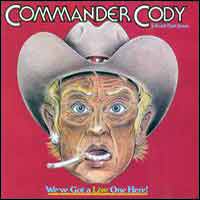 Der Schwanengesang der besten Hippie-Country-Rock'n'Roll-Band aller Zeiten, live in Europa mitgeschnitten.
Der Schwanengesang der besten Hippie-Country-Rock'n'Roll-Band aller Zeiten, live in Europa mitgeschnitten.

 Mehr ...
Mehr ...
|
This is really the final hurrah for the band inspite of the fact that
there were more recordings to follow. This is a two-record set from their
1976 tour of Europe with most of the original members still on board.
After this tour, George Frayne, aka Commander Cody, broke up the band
which now included Norton Buffalo. While this live recording is just as
powerful as the preceding, Live Deep in the Heart of Texas, it is obvious
that some of their fire is burning mighty low. Still, this bunch always
did their best work on stage and they never failed to satisfy. Full of
old standards, some new favorites and plenty of wattage to make it all
work just right, the stand out tunes here are the Commander Cody classics
like "Seeds and Stems," "Too Much Fun" and "Lost
in the Ozone." Other numbers that bring back the good old days include
the Airmen's version of "Milkcow Blues" and "San Antonio
Rose." Trucker songs, big with the Continental crowd, are "Semi
Truck," "Lookin' at the World Through a Windshield" and
"18 Wheels." Other numbers of note are "One of Those Nights,"
written by Farlow, Frayne and Kirchen, as well as the Commander's send
ups of "Smoke! Smoke! Smoke!," "Riot in Cell Block #9"
and "Hot Rod Lincoln." Always extraordinary, the era of Commander
Cody & His Lost Planet Airmen was a special moment in time that created
a place for hipsters, cosmic cowboys, rednecks and the working class to
all come together and enjoy some real American music. Never will there
be another band like this one or recordings like the ones they made between
1971 and 1976. They ended this project with "Lost in the Ozone,"
bringing the band and its audience full circle.
(by Jana Pendragon, All
Music Guide)
|
|
| The James Cotton Band: "Live & On The Move" (Buddah, 1976) |
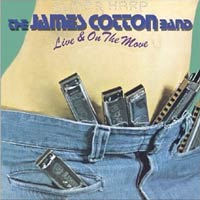 Eine der fetzigsten Bluesalben, das ich kenne: Mundharmonikahexer James
Cotton aus Chicago auf dem Zenit seines Könnens mit einer fantastischen
Band, in der u. a. Matt "Guitar" Murphy (der faule Ehemann
von Aretha Franklin im Blues-Brothers Film!) und Allen Toussaint
spielen. Das Cover ist natürlich ziemlich blöd und wirkt billig,
so wie auf den damals verbreiteten Ramschplatten vom Europa-Label,
wo unbekannte Studiomucker die Hits anderer Leute nachspielten und die
nur 5 DM kosteten. Außerdem hatte Buddah den Konzertmitschnitt damals
auf zwei Einzelplatten (Vol.1 und Vol.2) veröffentlicht. Ärgerlich
fand ich damals vor allem, dass ich ziemlich lange brauchte, um mir "Volume
2" zu besorgen, nachdem ich von "Volume 1" schon eine ganze
Zeit angefixt war. Ich gehe mal davon aus, dass Mr. Cotton damals nicht
viel zu sagen hatte ...
Eine der fetzigsten Bluesalben, das ich kenne: Mundharmonikahexer James
Cotton aus Chicago auf dem Zenit seines Könnens mit einer fantastischen
Band, in der u. a. Matt "Guitar" Murphy (der faule Ehemann
von Aretha Franklin im Blues-Brothers Film!) und Allen Toussaint
spielen. Das Cover ist natürlich ziemlich blöd und wirkt billig,
so wie auf den damals verbreiteten Ramschplatten vom Europa-Label,
wo unbekannte Studiomucker die Hits anderer Leute nachspielten und die
nur 5 DM kosteten. Außerdem hatte Buddah den Konzertmitschnitt damals
auf zwei Einzelplatten (Vol.1 und Vol.2) veröffentlicht. Ärgerlich
fand ich damals vor allem, dass ich ziemlich lange brauchte, um mir "Volume
2" zu besorgen, nachdem ich von "Volume 1" schon eine ganze
Zeit angefixt war. Ich gehe mal davon aus, dass Mr. Cotton damals nicht
viel zu sagen hatte ...
(10.09.2007)

 Mehr ...
Mehr ...
|
Originally released on two vinyl platters in 1976 by Buddah, this set
was digitally unleashed anew by the British Sequel label. It faithfully
captures the boogie-burning capabilities of the mid-'70s Cotton outfit,
fired by its leader's incendiary harp wizardry and Murphy's scintillating
licks.
(by Bill Dahl , All
Music Guide)
|
|
| Miles Davis: "Water Babies" (Columbia, 1976) |
 "Water Babies" gilt zwar in sog. "Fachkreisen" eher als schwächeres
Album des Meisters, aber immerhin ist es das erste, was ich mir damals
von ihm gekauft habe. Soweit ich mich erinnere ca. 1979 oder 1980 auf
der Urlaubs-Rückreise aus der Schweiz, und zwar in Trier, in einem
kleinen Plattenladen, als Sonderangebot. Damals kaum gehört weiß
ich es inzwischen aber sehr zu schätzen.
"Water Babies" gilt zwar in sog. "Fachkreisen" eher als schwächeres
Album des Meisters, aber immerhin ist es das erste, was ich mir damals
von ihm gekauft habe. Soweit ich mich erinnere ca. 1979 oder 1980 auf
der Urlaubs-Rückreise aus der Schweiz, und zwar in Trier, in einem
kleinen Plattenladen, als Sonderangebot. Damals kaum gehört weiß
ich es inzwischen aber sehr zu schätzen.
Die Platte ist zwar von '76, mitten aus Miles damaliger Auszeit, enthält
aber Aufnahmen von zwei Sessions vom Juni '67 (mit dem klassischen Quintett:
Wayne Shorter, Herbie Hancock, Tony Williams und
Ron Carter) und November '68 (mit beginnender Elektrifizierung:
Hancock und Neuzugang Chick Corea an den E-Pianos, Dave Holland
als Ersatz für Carter) und stellt damit das Bindeglied zwischen dem
alten, "akustischen" Miles ("Nefertiti")
und dem neuen, "elektrischen" Miles ("In
A Silent Way") dar. Eigentlich doch eine schöne Platte.
|
| Waylon Jennings, Willie Nelson, Jessi Colter, Tompall Glaser: "Wanted! The Outlaws" (RCA, 1976) |
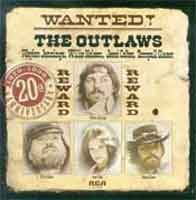 Waylon & Willie hielten zusammen mit Jessi Colter (Waylons Gattin) und Tompall Glaser diese gelungene Session ab. "Outlaw"-Country at it's best!
Waylon & Willie hielten zusammen mit Jessi Colter (Waylons Gattin) und Tompall Glaser diese gelungene Session ab. "Outlaw"-Country at it's best!
|
| Flora Purim: "Open Your Eyes, You Can Fly" (Milestone, 1976) |
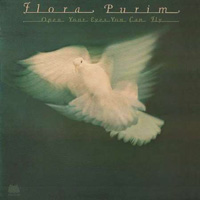 Gefunden in der Grabbelkiste!
Gefunden in der Grabbelkiste!
(28.02.2010)

 Mehr ...
Mehr ...
As an original member of Chick Corea's group Return to Forever, Purim subsequently drew praise as a solo act. Recording for the jazz label Milestone since 1973, Purim's sensual and strong voice was singular enough to withstand the pitfalls that hampered the work of many Latin jazz fusion artists. Open Your Eyes You Can Fly represents a commercial breakthrough, and has the artist again supplemented by adventurous players and top-notch songwriting. The best of the three Chick Corea tracks is the title song. With it's emotive and stinging guitar solo from David Amaro, it features Purim at her most accessible and charming. The remake of "Sometime Ago" has one of Corea's more accessible melodies, as Purim turns in one of her more sweet and fulfilling vocals. The melodic and soothing "San Francisco River" has the artist writing solely with frequent Corea collaborator Neville Potter on the evocative track. Despite the great work here, Open Your Eyes You Can Fly, lacks consistency. But with the great talents assembled and great voice, it's easy to overlook that fact. Hermeto Pascoal's "Andei (I Walked)" has a great synthesizer solo from George Duke and a flute solo from Pascoal. "Ina's Song (Trip to Bahia)" features Purim singing in Portuguese, starting off slow but then enlivened by her passion filled vocalizations. Produced by jazz producer Orrin Keepnews, this features the artist more lucid and joyful than some of her other work. For the reason it is recommended.
(by Jason Elias, All Music Guide)
|
| MaxRomeo: "War Ina Babylon" (Island, 1976) |
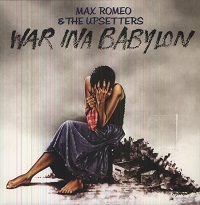

 Mehr ...
Mehr ...
Like the epochal Police & Thieves by Junior Murvin, which also originated at Lee "Scratch" Perry's Black Ark Studio and thus shares with this album Perry's trademark dark, swampy ambience, War ina Babylon is something of a mountain on the reggae landscape. But what makes it so remarkable is not just the consistently high quality of the music -- indeed, by 1976 one had come to expect nothing but the finest and heaviest grooves from Perry and his studio band, the Upsetters -- rather, it's the fact that Max Romeo had proved to be such a convincing singer of cultural (or "conscious") reggae after several years of raking it in as a purveyor of the most abject slackness. (His "Wet Dream" had been a huge hit in England several years earlier, and had been followed by such other delicacies as "Wine Her Goosie" and "Pussy Watch Man.") But there's no denying the authority of his admonishing voice here, and the title track (which describes the violent mood during Jamaica's 1972 general election) has remained a standard for decades. Other highlights include "One Step Forward" and "Smile Out a Style." Essential to any reggae collection.
(by Rick Anderson, All Music Guide)
|
| The Rowans: "Sibbling Rivalry" (Elektra/Asylum, 1976) |
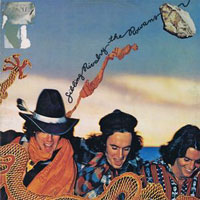 Lost & Found
Lost & Found
(27.04.2015)

 Mehr ...
Mehr ...
Although the Rowans — Peter (guitar/mandolin/vocals), Lorin (guitar/vocals), and Chris (guitar/flute) — hailed from Massachusetts, their rural leanings resurfaced on their third and arguably most accessible collection to date. The trio's strengths as musical chameleons are evident in both their writing and their eclectic performance styles. This is undoubtedly a double-edged sword, as it likewise made them difficult to adequately "market" to the typical mid-'70s pop music audience. Indeed, the term "progressive bluegrass" seems apt in capturing the modern directions that fuse the strict acoustic lineage and prowess of bluegrass with any number of disparate elements, such as jazz, pop, and country-rock. In addition to exploring those aural amalgamations, they venture into a rocksteady Rasta vibe on "Love Is" and even straight-ahead MOR during the slightly Philly soul-influenced "Ooh My Love." They don't stray far for very long, however, as "Tired Hands," "Mongolian Swamp/Kings Men," and the extended eight-plus minute "Joaquin Murrieta" venture closer to their conventional ancestry. The latter title is one of the more obvious examples of Peter Rowan's ability to augment a Spanish-flavored ballad with a sense of the decidedly American bluegrass tradition. The breezy vocals on "If I Only Could" scored the Rowans a little bit of chart action, conjuring up the laid-back slightly folkie sound of other West Coast acts such as the Eagles and America. The same can be said of the equally amiable "No Desanimes Amor (Don't Disappoint Love)," which also provides a suitable backdrop for their robust three-part harmonies. In 2004, Sibling Rivalry was issued on compact disc and paired with the follow-up, Jubilation (1977), onto a two-fer CD. As the LP had been out of print for over two decades, for many enthusiasts this release may well be their first opportunity to enjoy this classic recording. It is also recommended as the perfect starting point for the curious.
(by Lindsay Planer, All Music Guide)
|
| Otis Rush: "Right Place, Wrong Time" (Bullfrog, 1976) |
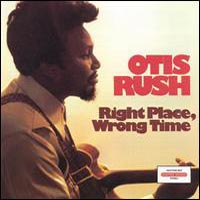 Lost & Found
Lost & Found
(11.01.2009)

 Mehr ...
Mehr ...
This recording session was not released until five years after it was done. One can imagine the tapes practically smoldering in their cases, the music is so hot. Sorry, there is nothing "wrong" about this blues album at all. Otis Rush was a great blues expander, a man whose guitar playing was in every molecule pure blues. On his solos on this album he strips the idea of the blues down to very simple gestures (i.e., a bent string, but bent in such a subtle way that the seasoned blues listener will be surprised). As a performer he opens up the blues form with his chord progressions and use of horn sections, the latter instrumentation again added in a wonderfully spare manner, bringing to mind a master painter working certain parts of a canvas in order to bring in more light. Blues fans who get tired of the same old song structures, riff, and rhythms should be delighted with most of Rush's output, and this one is among his best. Sometimes all he does to make a song sound unlike any blues one has ever heard is just a small thing � a chord moving up when one expects it go down, for example. The production is particularly skilled, and the fact that Capitol Records turned this session down after originally producing it can only be reasonably accepted when combined with other decisions this label has made, such as turning down the Doors because singer Jim Morrison had "no charisma." This record doesn't mess around at all. The first track takes off like the man they fire out of a cannon at the end of a circus, a perceived climax swaggeringly representing just the beginning, after all. Some of the finest tracks are the ones that go longer than five minutes, allowing the players room to stretch. And that means more of Rush's great guitar playing, of course. For the final track he leaves the blues behind completely for a moving cover version of "Rainy Night in Georgia" by Tony Joe White.
(by Eugene Chadbourne, All Music Guide)
|
| John David Souther: "Black Rose" (Elektra, 1976) |
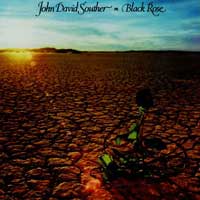 Eigentlich kennt man ihn nur als Songschreiber für Linda Ronstadt
und die Eagles, aber er hat auch einige wenige und schöne eigene Platten gemacht.
Perfekter Westcoast-Pop (mit David Crosby, Linda Ronstadt,
Lowell George, Andrew Gold, Joe Walsh, Jim Keltner,
Glenn Frey, Art Garfunkel, Waddy Wachtel u.v.a.)
mit ein paar jazzigen Farbtupfern von Stanley Clarke (Kontrabass)
und Donald Byrd (Flügelhorn)
Eigentlich kennt man ihn nur als Songschreiber für Linda Ronstadt
und die Eagles, aber er hat auch einige wenige und schöne eigene Platten gemacht.
Perfekter Westcoast-Pop (mit David Crosby, Linda Ronstadt,
Lowell George, Andrew Gold, Joe Walsh, Jim Keltner,
Glenn Frey, Art Garfunkel, Waddy Wachtel u.v.a.)
mit ein paar jazzigen Farbtupfern von Stanley Clarke (Kontrabass)
und Donald Byrd (Flügelhorn) |
| Collin Walcott: "Cloud Dance" (ECM, 1976) |
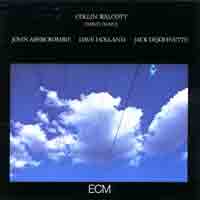 Collin Walcott war (er ist leider vor einigen Jahren in der DDR
mit dem Auto tödlich verunglückt!) und ist für mich auch
heute noch der einzige europäische bzw. US-amerikanische Musiker,
der sich je ernsthaft, erfolgreich und hauptsächlich mit den indischen
Instrumenten Sitar und Tabla auseinandergesetzt hat. Zuerst Ende der 60er
mit Klarinettist Tony Scott und dann in der Band "Winter
Consort" vom Sopransaxofonisten Paul Winter aktiv und
danach und bis zu seinem Tode (welches Jahr weiß ich leider nicht) mit
Ralph Towner, Glen Moore und Paul McCandless als
Oregon erfolgreich, veröffentlichte
er auf dem deutschen Jazz-Kultlabel ECM mehrere Projektalben, z.B.
unter dem Namen Codona mit Don
Cherry und Nana Vasconcelos, aber auch sehr schöne Soloalben.
Auf "Cloud Dance" hatte er eine wunderbare Band um sich geschart:
Gitarrist John Abercrombie, Bassist Dave Holland und Trommler
Jack DeJohnette.
Collin Walcott war (er ist leider vor einigen Jahren in der DDR
mit dem Auto tödlich verunglückt!) und ist für mich auch
heute noch der einzige europäische bzw. US-amerikanische Musiker,
der sich je ernsthaft, erfolgreich und hauptsächlich mit den indischen
Instrumenten Sitar und Tabla auseinandergesetzt hat. Zuerst Ende der 60er
mit Klarinettist Tony Scott und dann in der Band "Winter
Consort" vom Sopransaxofonisten Paul Winter aktiv und
danach und bis zu seinem Tode (welches Jahr weiß ich leider nicht) mit
Ralph Towner, Glen Moore und Paul McCandless als
Oregon erfolgreich, veröffentlichte
er auf dem deutschen Jazz-Kultlabel ECM mehrere Projektalben, z.B.
unter dem Namen Codona mit Don
Cherry und Nana Vasconcelos, aber auch sehr schöne Soloalben.
Auf "Cloud Dance" hatte er eine wunderbare Band um sich geschart:
Gitarrist John Abercrombie, Bassist Dave Holland und Trommler
Jack DeJohnette. |
| Kenny Wheeler: "Gnu High" (ECM, 1976) |
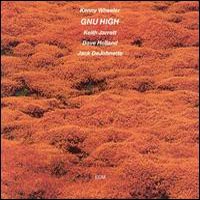 Das erste Album des Kanadiers für das ECM-Label: Wheeler nur am
Flügelhorn und im Quartett mit den allerbesten Kollegen: Dave Holland
am Bass, Jack DeJohnette am Schlagzeug und Keith Jarrett
am Piano. Letzterer liefert hier als ungewöhnlich zurückhaltender Begleiter
eine seiner aus meiner Sicht allerbesten Leistungen überhaupt ab. Perfekte
ECM-Musik.
Das erste Album des Kanadiers für das ECM-Label: Wheeler nur am
Flügelhorn und im Quartett mit den allerbesten Kollegen: Dave Holland
am Bass, Jack DeJohnette am Schlagzeug und Keith Jarrett
am Piano. Letzterer liefert hier als ungewöhnlich zurückhaltender Begleiter
eine seiner aus meiner Sicht allerbesten Leistungen überhaupt ab. Perfekte
ECM-Musik.
(09.04.2009)

 Mehr ...
Mehr ...
When Kenny Wheeler expatriated from his native Canada to England, it was not headline news. But upon the release of Gnu High, he became a contemporary jazz figure to be recognized, revered and admired. Playing the flugelhorn exclusively for this, his ECM label debut, Wheeler's mellifluous tones and wealth of ideas came to full fruition. Whether chosen in collaboration with label boss Manfred Eicher or by Wheeler alone, picking pianist Keith Jarrett, bassist Dave Holland and drummer Jack DeJohnette was a stroke of genius. They support the elongated and extended notions of Wheeler's in many real and important ways. What is also extant is a sense of self-indulgence, real for listeners with short attention spans. "Heyoke" is such a piece rife for this discussion at nearly 22 minutes. This lilting waltz is at once atmospheric and soulful, a fairly fresh and inventive style turned more dramatic near the finish of this magnum opus. It's all fueled by the reinvented swing of DeJohnette. Jarrett's vocal whining is kept in check, as his pretty pianistics buoy Wheeler's notions in Zen inspired time and eventually no time improvisations. "Gnu Suite" is similarly rendered in an unforced 4/4 rhythm, but Wheeler is more animated. There's a plus-plus solo from Holland before the group merges into a floating and flowing discourse again in free time. The special track is "Smatter" and at just under six minutes works better, not only for radio airplay, but also in its concise melodic construct by means of the regal and happy persona Wheeler portrays. Pure melody and a repeated anchoring seven-note phrase insert sets this tune apart from the rest. It also clearly identifies the warm and cool stance only Wheeler wields, making seemingly simple music deep and profound. Certainly this was an auspicious starting point, albeit long winded, for a magical performer whose sound and smarts captured the imagination of so many fellow musicians and listeners from this point onward.
(by Michael G. Nastos, All Music Guide)
|
 Das Album des Jahres
Das Album des Jahres weitere Highlights ...
weitere Highlights ...  Die
erste Platte von Mark Boston, Bill Harkleroad und Art
Tripp III, besser bekannt als "Rockette Morton", "Zoot
Horn Rollo" und "Ed Marimba" aus Captain Beafheart's
Magic Band von "Trout Mask Replica"
(1969) bis "Unconditionally Guaranteed" (1974). Es gibt sogar
eine Coverversion vom texanischen Songschreiber Guy
Clark: "Desperados Waiting For The Train". Bezahlt hatte
diese Plattenaufnahme übrigens Ian Anderson von Jethro
Tull, ein großer Beefheart-Fan.
Die
erste Platte von Mark Boston, Bill Harkleroad und Art
Tripp III, besser bekannt als "Rockette Morton", "Zoot
Horn Rollo" und "Ed Marimba" aus Captain Beafheart's
Magic Band von "Trout Mask Replica"
(1969) bis "Unconditionally Guaranteed" (1974). Es gibt sogar
eine Coverversion vom texanischen Songschreiber Guy
Clark: "Desperados Waiting For The Train". Bezahlt hatte
diese Plattenaufnahme übrigens Ian Anderson von Jethro
Tull, ein großer Beefheart-Fan. Ein
gutes Beispiel dafür, dass Talent und Erfolg nicht unbedingt zusammenfinden
müssen: Jess Roden ist einer der besten englischen Rock/Soul-Sänger
und gehört in eine Reihe mit Rod Stewart, Steve Winwood, Paul Carrack
und Robert Palmer, ohne allerdings jemals deren Bekanntheitsgrad erreicht
zu haben. Nach zwei Alben mit der Countryrockband Bronco,
einem kurzen Abstecher bei der Butts Band
mit Robbie Krieger und John Densmore als Jim Morrison-Ersatz
und einer zwar sehr schönen, aber erfolglosen Soloplatte, in New
Orleans mit dem Produzenten Allan Toussaint und den Meters
als Begleitband aufgenommen, gründete er seine eigene Band, mit der
er es innerhalb kürzester Zeit immerhin auf 2 Studio- und ein Livealbum
brachte. Alle drei Platten präsentieren wunderbaren Soulrock. Ausgewählt
habe ich das Debütalbum der Band, dass ich irgendwann mal für
ein paar Mark aus der Grabbelkiste gezogen habe: der Platz, an dem (leider)
viele gute Platten landen (und eines meiner Hauptjagdreviere!). Die Band
ohne bekannte Gesichter spielt ausgezeichnet: Steve Webb und Bruce
Roberts an den Gitarren, Pete Hunt (dr) und John Cartwright
(bg) in der Rhythmusgruppe und Chris Gower (Posaune) und Ronnie
Taylor (Sax) als fester Bläsersatz. Die Songs stammen zur einen
Hälfte von Bandmitgliedern (Roden, Webb und Cartwright), es gibt
aber auch tolle Coverversionen aus den Bereichen Rock, Soul & Country:
das Titelstück "You Can Leave Your Hat On" von Randy
Newman (hier viel besser als bei Josef Cocker aufgehoben!), "Mama
Roux" (Dr. John), "Desperado" von den Eagles
(besser als das Original!) und die Nashvilleballade "Too Far Gone"
(Billy Sherrill).
Ein
gutes Beispiel dafür, dass Talent und Erfolg nicht unbedingt zusammenfinden
müssen: Jess Roden ist einer der besten englischen Rock/Soul-Sänger
und gehört in eine Reihe mit Rod Stewart, Steve Winwood, Paul Carrack
und Robert Palmer, ohne allerdings jemals deren Bekanntheitsgrad erreicht
zu haben. Nach zwei Alben mit der Countryrockband Bronco,
einem kurzen Abstecher bei der Butts Band
mit Robbie Krieger und John Densmore als Jim Morrison-Ersatz
und einer zwar sehr schönen, aber erfolglosen Soloplatte, in New
Orleans mit dem Produzenten Allan Toussaint und den Meters
als Begleitband aufgenommen, gründete er seine eigene Band, mit der
er es innerhalb kürzester Zeit immerhin auf 2 Studio- und ein Livealbum
brachte. Alle drei Platten präsentieren wunderbaren Soulrock. Ausgewählt
habe ich das Debütalbum der Band, dass ich irgendwann mal für
ein paar Mark aus der Grabbelkiste gezogen habe: der Platz, an dem (leider)
viele gute Platten landen (und eines meiner Hauptjagdreviere!). Die Band
ohne bekannte Gesichter spielt ausgezeichnet: Steve Webb und Bruce
Roberts an den Gitarren, Pete Hunt (dr) und John Cartwright
(bg) in der Rhythmusgruppe und Chris Gower (Posaune) und Ronnie
Taylor (Sax) als fester Bläsersatz. Die Songs stammen zur einen
Hälfte von Bandmitgliedern (Roden, Webb und Cartwright), es gibt
aber auch tolle Coverversionen aus den Bereichen Rock, Soul & Country:
das Titelstück "You Can Leave Your Hat On" von Randy
Newman (hier viel besser als bei Josef Cocker aufgehoben!), "Mama
Roux" (Dr. John), "Desperado" von den Eagles
(besser als das Original!) und die Nashvilleballade "Too Far Gone"
(Billy Sherrill).  "Desire"
ist das Album nach dem Meisterwerk "Blood
On The Tracks", die meisten Songs hat Dylan (sehr ungewöhnlich
für ihn) zusammen mit dem Texter Jacques Levy geschrieben,
herausragend sind dabei "Hurricane", "Joey", "Oh
Sister", "One More Cup Of Coffee" und "Sara".
Außerdem ist eine komplett neue Begleitband zu hören, in der diesesmal
sogar zwei Frauen auffallen: Emmylou Harris
singt wie zuvor bei Gram Parsons fast durchgängig zweite Stimme,
Scarlet Riveras Geige dominiert die meisten Songs.
"Desire"
ist das Album nach dem Meisterwerk "Blood
On The Tracks", die meisten Songs hat Dylan (sehr ungewöhnlich
für ihn) zusammen mit dem Texter Jacques Levy geschrieben,
herausragend sind dabei "Hurricane", "Joey", "Oh
Sister", "One More Cup Of Coffee" und "Sara".
Außerdem ist eine komplett neue Begleitband zu hören, in der diesesmal
sogar zwei Frauen auffallen: Emmylou Harris
singt wie zuvor bei Gram Parsons fast durchgängig zweite Stimme,
Scarlet Riveras Geige dominiert die meisten Songs. Das
zweite Album des texanischen Geschichtenerzähler, wie schon beim
ersten Mal mit ausgezeichneten Begleitern (Rodney
Crowell, Emmylou Harris, Jerry
Jeff Walker, Nicolette Larson,
Tracy Nelson, Waylon Jennings, Hoyt Axton,
u. a.) und exquisitem Songmaterial (z.B. der Titelsong, "Broken Hearted
People" und "Last Gunfighter Ballad")
Das
zweite Album des texanischen Geschichtenerzähler, wie schon beim
ersten Mal mit ausgezeichneten Begleitern (Rodney
Crowell, Emmylou Harris, Jerry
Jeff Walker, Nicolette Larson,
Tracy Nelson, Waylon Jennings, Hoyt Axton,
u. a.) und exquisitem Songmaterial (z.B. der Titelsong, "Broken Hearted
People" und "Last Gunfighter Ballad") Der Mann hat es seinem Publikum nicht leicht gemacht: ein halbes Jahr
zuvor erschien mit "Metal Machine Music" eine unhörbare
"Krachplatte" im wahrsten Sinne des Wortes, die auch für
meine Ohren zu anstrengend ist. Danach dann mit "Coney Island Baby"
plötzlich wieder eine Platte mit wunderschönen Liedern!
Der Mann hat es seinem Publikum nicht leicht gemacht: ein halbes Jahr
zuvor erschien mit "Metal Machine Music" eine unhörbare
"Krachplatte" im wahrsten Sinne des Wortes, die auch für
meine Ohren zu anstrengend ist. Danach dann mit "Coney Island Baby"
plötzlich wieder eine Platte mit wunderschönen Liedern!
 Mehr ...
Mehr ...
 Jerrys drittes Soloalbum, zur Hälfte mit Grateful
Dead, zur Hälfte mit seiner eigenen Band (John Kahn, Nicky
Hopkins und Ron Tutt) eingespielt. Ein paar schöne eigene Songs
(ich mag besonders "Comes A Time"), aber auch ein paar sehr
schöne Coversongs (z.B. das entschleunigte und zum Reggae umgebaute Bluegrassstück
"Catfish John" und das wunderbare "On Your Way Down"
von Allen Toussaint). Das Album ist um Klassen besser als sein
Ruf in der Deadhead-Gemeinde.
Jerrys drittes Soloalbum, zur Hälfte mit Grateful
Dead, zur Hälfte mit seiner eigenen Band (John Kahn, Nicky
Hopkins und Ron Tutt) eingespielt. Ein paar schöne eigene Songs
(ich mag besonders "Comes A Time"), aber auch ein paar sehr
schöne Coversongs (z.B. das entschleunigte und zum Reggae umgebaute Bluegrassstück
"Catfish John" und das wunderbare "On Your Way Down"
von Allen Toussaint). Das Album ist um Klassen besser als sein
Ruf in der Deadhead-Gemeinde.
 Mehr ...
Mehr ...
 Dieser Platte hat mich immer zum Lachen gebracht. Guru Guru '76 haben nicht
mehr viel mit dem "Spacerock" vom Anfang der 70er zu tun.
Stattdessen hören wir relativ "normalen" Rock mit Jazz-,
Latin- und Alpenfolklore(!)-Einflüssen. Dazu kommen Nonsens-Texte
und kleine Hörspiele. Neben dem Bandgründer und Trommler Mani
Neumeier gehören Ex-Brainstorm-Musiker
Roland Schaeffer (Gitarre, Sax, Gesang), der Krefelder Jogi
Karpenkiel (Bass) und der österreicher Sepp Jandrisits
(Gitarre, Akkordeon) zur aktuellen Besetzung.
Dieser Platte hat mich immer zum Lachen gebracht. Guru Guru '76 haben nicht
mehr viel mit dem "Spacerock" vom Anfang der 70er zu tun.
Stattdessen hören wir relativ "normalen" Rock mit Jazz-,
Latin- und Alpenfolklore(!)-Einflüssen. Dazu kommen Nonsens-Texte
und kleine Hörspiele. Neben dem Bandgründer und Trommler Mani
Neumeier gehören Ex-Brainstorm-Musiker
Roland Schaeffer (Gitarre, Sax, Gesang), der Krefelder Jogi
Karpenkiel (Bass) und der österreicher Sepp Jandrisits
(Gitarre, Akkordeon) zur aktuellen Besetzung.
 Mitten in den 70ern in England so was wie Country-Pubrock spielen? Mit
Reggae-Elementen? Mit Banjo, Pedal-Steel und Moog-Synthesizer? Und der
Trommler schreibt die Songs? Bescheuert? Vielleicht. Aber eben auch was
für Leute mit schrägem Geschmack wie mich. Und mit einer der
besten Coverversionen von einem Nick-Lowe-Song:
"Television".
Mitten in den 70ern in England so was wie Country-Pubrock spielen? Mit
Reggae-Elementen? Mit Banjo, Pedal-Steel und Moog-Synthesizer? Und der
Trommler schreibt die Songs? Bescheuert? Vielleicht. Aber eben auch was
für Leute mit schrägem Geschmack wie mich. Und mit einer der
besten Coverversionen von einem Nick-Lowe-Song:
"Television".
 Mehr ...
Mehr ...
 Das Solodebüt des damals noch sehr jungen Gitarristen, im Trio mit
Billy Hart am Schlagzeug und dem ebenfalls noch sehr jungen Jaco
Pastorius am Bass eingespielt.
Das Solodebüt des damals noch sehr jungen Gitarristen, im Trio mit
Billy Hart am Schlagzeug und dem ebenfalls noch sehr jungen Jaco
Pastorius am Bass eingespielt.
 Mehr ...
Mehr ...
 Lost And Found!
Lost And Found! Mehr ...
Mehr ...
 1976 legten die Grateful Dead eine Pause ein und der rastlose Bob
Weir machte Kingfish zu seiner neuen Truppe, ohne dort allerdings
im Mittelpunkt zu stehen. Zwei seiner Freunde, der Harpspieler und Slidegitarrist
Matt Kelly, sowie der Sänger und Bassist Dave Torbert
(Ex-New Riders Of The Purple Sage) spielten
schon seit 1973 unter dem Name "Kingfish" zusammen, bekamen
aber durch den prominenten Neuzugang einen Schub nach vorne, sodass es
zu dieser Studioplatte und einem Livealbum auf dem Grateful-Dead-Label
Round kam. 1977 erschien noch eine weitere Studioplatte ohne Weir
(der wieder voll mit den Dead beschäftigt war) und es gab sogar einen
Rockpalast-Auftritt. Danach verschwand diese tolle Band aber wieder
in der Obskurität.
1976 legten die Grateful Dead eine Pause ein und der rastlose Bob
Weir machte Kingfish zu seiner neuen Truppe, ohne dort allerdings
im Mittelpunkt zu stehen. Zwei seiner Freunde, der Harpspieler und Slidegitarrist
Matt Kelly, sowie der Sänger und Bassist Dave Torbert
(Ex-New Riders Of The Purple Sage) spielten
schon seit 1973 unter dem Name "Kingfish" zusammen, bekamen
aber durch den prominenten Neuzugang einen Schub nach vorne, sodass es
zu dieser Studioplatte und einem Livealbum auf dem Grateful-Dead-Label
Round kam. 1977 erschien noch eine weitere Studioplatte ohne Weir
(der wieder voll mit den Dead beschäftigt war) und es gab sogar einen
Rockpalast-Auftritt. Danach verschwand diese tolle Band aber wieder
in der Obskurität.
 Mehr ...
Mehr ...
 Man letztes Studioalbum vor dem Ende der Band sollte eigentlich ein Neuanfang
werden: ein neues Plattenlabel, nachdem die "waliser Grateful Dead"
(oder "britischen Allman Brothers") jahrelang bei United Artists
zuhause waren, ein neuer Bassist (John McKenzie, Ex-Global Village
Trucking Company) und an den Keyboards Heimkehrer Phil Ryan.
Beide beflügeln die Altgedienten (Deke Leonard, Micky Jones
und Trommler Terry Williams) zu Höchstleistungen. Vielleicht
ist das nicht das beliebteste Album der Band und auch nicht die populärste
Besetzung - aber sicher die musikalisch beste. Davon kann man sich dann
auch noch auf dem Livealbum "All's Well
That Ends Well" von den Abschiedskonzerten im Dezember 1976 aus
dem Londoner Roundhouse überzeugen, das im Jahr 1977 herauskam und
wohl nur zur Vertragserfüllung diente.
Man letztes Studioalbum vor dem Ende der Band sollte eigentlich ein Neuanfang
werden: ein neues Plattenlabel, nachdem die "waliser Grateful Dead"
(oder "britischen Allman Brothers") jahrelang bei United Artists
zuhause waren, ein neuer Bassist (John McKenzie, Ex-Global Village
Trucking Company) und an den Keyboards Heimkehrer Phil Ryan.
Beide beflügeln die Altgedienten (Deke Leonard, Micky Jones
und Trommler Terry Williams) zu Höchstleistungen. Vielleicht
ist das nicht das beliebteste Album der Band und auch nicht die populärste
Besetzung - aber sicher die musikalisch beste. Davon kann man sich dann
auch noch auf dem Livealbum "All's Well
That Ends Well" von den Abschiedskonzerten im Dezember 1976 aus
dem Londoner Roundhouse überzeugen, das im Jahr 1977 herauskam und
wohl nur zur Vertragserfüllung diente.
 Mehr ...
Mehr ...
 Ich bin eigentlich überhaupt kein Cocker-Fan. Und dies ist sicherlich
weder sein bekanntestes noch sein bestes Album - aber ich mag es sehr:
schöne Songs (meist von Bobby Charles und Matthew Moore),
aber vor allem eingespielt in Jamaika (!) mit einer tollen Band: The
Stuff. Dahinter verbergen sich New-Yorker Studiocracks der ersten
Liga: Gordon Edwards (Bass), Richard Tee (keyboards), Cornell
Dupree und Eric Gale an den Gitarren, sowie Steve Gadd
am Schlagzeug.
Ich bin eigentlich überhaupt kein Cocker-Fan. Und dies ist sicherlich
weder sein bekanntestes noch sein bestes Album - aber ich mag es sehr:
schöne Songs (meist von Bobby Charles und Matthew Moore),
aber vor allem eingespielt in Jamaika (!) mit einer tollen Band: The
Stuff. Dahinter verbergen sich New-Yorker Studiocracks der ersten
Liga: Gordon Edwards (Bass), Richard Tee (keyboards), Cornell
Dupree und Eric Gale an den Gitarren, sowie Steve Gadd
am Schlagzeug. Mehr ...
Mehr ...
 Was
für ein grandioses Debüt: Graham Parker mit seiner Band, in
der sich Musiker von zwei frisch aufgelösten Pubrockbands trafen:
Brinsley Schwarz (g) und Bob Andrews (keyb) kamen von Brinsley
Schwarz, Martin Belmont (g) kam von Ducks
Deluxe, Andy Bodnar (bg) und Steve Goulding (dr) spielten
vorher auch bei einer Pubrockband, deren Name mir aber im Moment leider
nicht einfällt. Produziert hatte Nick Lowe (ebenfalls von
Brinsley Schwarz). Das alles
wäre aber nichts ohne die Songs von Graham Parker: "Between
You And Me", "Don't Ask Me Questions", "Soul Shoes",
"White Honey", etc.
Was
für ein grandioses Debüt: Graham Parker mit seiner Band, in
der sich Musiker von zwei frisch aufgelösten Pubrockbands trafen:
Brinsley Schwarz (g) und Bob Andrews (keyb) kamen von Brinsley
Schwarz, Martin Belmont (g) kam von Ducks
Deluxe, Andy Bodnar (bg) und Steve Goulding (dr) spielten
vorher auch bei einer Pubrockband, deren Name mir aber im Moment leider
nicht einfällt. Produziert hatte Nick Lowe (ebenfalls von
Brinsley Schwarz). Das alles
wäre aber nichts ohne die Songs von Graham Parker: "Between
You And Me", "Don't Ask Me Questions", "Soul Shoes",
"White Honey", etc. Mehr ...
Mehr ...
 Eine meiner lange nicht gehörten Schallplatten aus vergangener Zeit mit
verwirrenden Namen! Zum einen hiess eines der ersten deutschen Independent-Labels
damals noch "April", bevor es sich unter juristischem
Druck einer großen Plattenfirma, die bereits eine Label mit diesem
Namen hatte, in "Schneeball" umtaufte. "For
Missus Beastly" war die erste Veröffentlichung des Labels
und stammte - nach meinem damaligen Kenntnisstand - von der Band
"Dr. Aftershave & The Mixed-Pickles". Aber
eigentlich handelt es sich um ein Album der ursprünglich aus
Ostwestfalen stammenden Band "Missus Beastly",
die entweder großem Humor hatte oder noch bei einer anderen Firma
unter Vertrag war, sodass sie ein Pseudonym brauchte. Oder beides.
Eine meiner lange nicht gehörten Schallplatten aus vergangener Zeit mit
verwirrenden Namen! Zum einen hiess eines der ersten deutschen Independent-Labels
damals noch "April", bevor es sich unter juristischem
Druck einer großen Plattenfirma, die bereits eine Label mit diesem
Namen hatte, in "Schneeball" umtaufte. "For
Missus Beastly" war die erste Veröffentlichung des Labels
und stammte - nach meinem damaligen Kenntnisstand - von der Band
"Dr. Aftershave & The Mixed-Pickles". Aber
eigentlich handelt es sich um ein Album der ursprünglich aus
Ostwestfalen stammenden Band "Missus Beastly",
die entweder großem Humor hatte oder noch bei einer anderen Firma
unter Vertrag war, sodass sie ein Pseudonym brauchte. Oder beides. Mehr ...
Mehr ...
 Das einzige Soloalbum des Moody Blues-Keyborders habe ich mir damals
eigentlich nur gekauft, weil es eben etwas mit den Moody Blues
zu tun hatte. Richtig gut fand ich es nicht mit seinem für die Moodies
untypischen Sound weg vom Mellotron, hin zum laidback-Westcoastsound seiner
Wahlheimat Kalifornien. Nur die jazzige Nummer "Someone To Believe
In" mit dem wuchtigen Kontrabass von Joel Dibartello und der
Flöte von Tom Peterson mochte ich schon immer.
Das einzige Soloalbum des Moody Blues-Keyborders habe ich mir damals
eigentlich nur gekauft, weil es eben etwas mit den Moody Blues
zu tun hatte. Richtig gut fand ich es nicht mit seinem für die Moodies
untypischen Sound weg vom Mellotron, hin zum laidback-Westcoastsound seiner
Wahlheimat Kalifornien. Nur die jazzige Nummer "Someone To Believe
In" mit dem wuchtigen Kontrabass von Joel Dibartello und der
Flöte von Tom Peterson mochte ich schon immer.  Mehr ...
Mehr ...
 Mein Lieblingsalbum der Band um den Sänger und Songschreiber Peter
Hammill, vor allem wegen der Songs "Pilgrim" und "Still
Life".
Mein Lieblingsalbum der Band um den Sänger und Songschreiber Peter
Hammill, vor allem wegen der Songs "Pilgrim" und "Still
Life".
 Mehr ...
Mehr ...
 Mal wieder einer der vielen künstlerisch überzeugenden, aber kommerziell
gescheiterten Bandversuche. Allan Taylor, englischer Singer/Songwriter,
versuchte mit seinen Partnern Brian Golbey (Geige) und Jon Gillaspie
(keyb) und einer von Fairport Convention
ausgeliehenen Rhythmusgruppe (Dave Pegg und Dave Mattacks)
und dem Slidegitarren Bryn Haworth
eine Fusion aus Folk und Cajun, England und New Orleans. Klasse zu hören
- kennt aber mal wieder kein Schwein!
Mal wieder einer der vielen künstlerisch überzeugenden, aber kommerziell
gescheiterten Bandversuche. Allan Taylor, englischer Singer/Songwriter,
versuchte mit seinen Partnern Brian Golbey (Geige) und Jon Gillaspie
(keyb) und einer von Fairport Convention
ausgeliehenen Rhythmusgruppe (Dave Pegg und Dave Mattacks)
und dem Slidegitarren Bryn Haworth
eine Fusion aus Folk und Cajun, England und New Orleans. Klasse zu hören
- kennt aber mal wieder kein Schwein! Zu Unrecht haben Poco immer nur am Katzentisch auf dem Olymp des Country-Rocks
gesessen, vielleicht weil ihre Mitglieder entweder von berühmteren
Bands des Genres stammten (die bei "Rose Of Cimarron" nicht
mehr dazugehörigen Richie Furay und Jim Messina kamen
von Buffalo Springfield) oder zu solchen
Bands überliefen (Ur-Bassist Randy Meissner war später
Gründungsmitglied der Eagles,
zu denen auch der aktuelle Bassist Tim Schmitt bald abwandern wird).
Trotz aller Hindernisse wurden Poco als Band und Songschreiber immer besser,
nicht zuletzt deshalb, weil Rusty Young, zu Anfang "nur"
der Pedalsteel-Spieler in der Gruppe, weil man ja mit Furay und Messina
bereits zwei hochkarätige Mitarbeiter in den Arbeitsbereichen Gitarre,
Gesang und Komposition in den eigenen Reihen hatte, eine immer wichtigere
Rolle auch bei diesen Aufgaben erfüllte. So stammt von ihm auch der
von mir in's Herz geschlossene wunderschöne Titelsong, den später
auch Emmylou Harris aufnehmen wird und der auch heutzutage sogar
noch manchmal bei WDR4 zu hören ist!
Zu Unrecht haben Poco immer nur am Katzentisch auf dem Olymp des Country-Rocks
gesessen, vielleicht weil ihre Mitglieder entweder von berühmteren
Bands des Genres stammten (die bei "Rose Of Cimarron" nicht
mehr dazugehörigen Richie Furay und Jim Messina kamen
von Buffalo Springfield) oder zu solchen
Bands überliefen (Ur-Bassist Randy Meissner war später
Gründungsmitglied der Eagles,
zu denen auch der aktuelle Bassist Tim Schmitt bald abwandern wird).
Trotz aller Hindernisse wurden Poco als Band und Songschreiber immer besser,
nicht zuletzt deshalb, weil Rusty Young, zu Anfang "nur"
der Pedalsteel-Spieler in der Gruppe, weil man ja mit Furay und Messina
bereits zwei hochkarätige Mitarbeiter in den Arbeitsbereichen Gitarre,
Gesang und Komposition in den eigenen Reihen hatte, eine immer wichtigere
Rolle auch bei diesen Aufgaben erfüllte. So stammt von ihm auch der
von mir in's Herz geschlossene wunderschöne Titelsong, den später
auch Emmylou Harris aufnehmen wird und der auch heutzutage sogar
noch manchmal bei WDR4 zu hören ist!
 Mehr ...
Mehr ...
 Ein grandioses Debüt, das ich leider erst viel, viel später
zu schätzen gelernt habe!
Ein grandioses Debüt, das ich leider erst viel, viel später
zu schätzen gelernt habe!
 Mehr ...
Mehr ...
 Reids zweites amerikanisches Album habe ich, wie viele andere, damals
aus der Grabbelkiste gezogen. Produziert hatte Graham Nash, der
auch für den Chorgesang sorgt und eine leichte, aber nicht unangenehme
Countryfärbung in viele der Lieder bringt (es spielen u. a. David
Lindley, Ben Keith und Al Perkins). Dazu gibt es in
einigen Titeln klasse Bläsersätze. "Fooling You" ist
mein Lieblingslied von der Platte, eine wunderschöne Ballade mit
Wurlitzer-Piano. Da kein Pianist in den Credits aufgeführt wird,
wahrscheinlich sogar von Reid selbst gespielt. Insgesamt finde ich das
Album viel besser als es manche der damaligen Kritiken formulierten.
Reids zweites amerikanisches Album habe ich, wie viele andere, damals
aus der Grabbelkiste gezogen. Produziert hatte Graham Nash, der
auch für den Chorgesang sorgt und eine leichte, aber nicht unangenehme
Countryfärbung in viele der Lieder bringt (es spielen u. a. David
Lindley, Ben Keith und Al Perkins). Dazu gibt es in
einigen Titeln klasse Bläsersätze. "Fooling You" ist
mein Lieblingslied von der Platte, eine wunderschöne Ballade mit
Wurlitzer-Piano. Da kein Pianist in den Credits aufgeführt wird,
wahrscheinlich sogar von Reid selbst gespielt. Insgesamt finde ich das
Album viel besser als es manche der damaligen Kritiken formulierten.
 Mehr ...
Mehr ...
 Sein ersten Album für Asylum, quasi sein Debüt (es gibt noch ein
älteres Album von 1970, das ich aber leider nicht kenne). Erste Aufmerksamkeit
bekam er damals, als Linda Ronstadt mehrere seiner
Lieder coverte. Produziert hatte sein Kumpel Jackson Browne, der
die gesamte L.A. Prominenz ins Studio holte (Glenn Frey und Don
Henley von den Eagles, Phil
Everly, Bonnie Raitt, David
Lindley, Stevie Nicks und Lindsey Buckingham von Fleetwood
Mac, etc.), aber die Qualität dieses Albums beruht in erster
Linie auf Mr. Zevon und seinen beeindruckenden Liedern, z.B. "Hasten
Down The Wind", "Carmelita", "Poor, Poor Pitiful Me"
und natürlich "Mohammed's Radio".
Sein ersten Album für Asylum, quasi sein Debüt (es gibt noch ein
älteres Album von 1970, das ich aber leider nicht kenne). Erste Aufmerksamkeit
bekam er damals, als Linda Ronstadt mehrere seiner
Lieder coverte. Produziert hatte sein Kumpel Jackson Browne, der
die gesamte L.A. Prominenz ins Studio holte (Glenn Frey und Don
Henley von den Eagles, Phil
Everly, Bonnie Raitt, David
Lindley, Stevie Nicks und Lindsey Buckingham von Fleetwood
Mac, etc.), aber die Qualität dieses Albums beruht in erster
Linie auf Mr. Zevon und seinen beeindruckenden Liedern, z.B. "Hasten
Down The Wind", "Carmelita", "Poor, Poor Pitiful Me"
und natürlich "Mohammed's Radio". 1976 sah es zuerst aus, als würde es eine komplette CSNY Reunion geben.
Dann gab's aber doch "nur" zwei Duo-Platten. Während die
alten Streithähne Stephen und Neil sich zur Stills-Young-Band
zusammentaten, lieferten David und Graham eine schöne,
wenn auch etwas leichtgewichtige Westcoastplatte ab, bei der sie von David
Lindley, Danny Kortchmar (g), Craig Doerge (keyb), Tim
Drummond (bg) und Russ Kunkel (dr) begleitet wurden. Obwohl
die Platte teilweise von der Kritik zerrissen wurde, hat sie für
mich eine gewisse Bedeutung als schöne Hintergrundmusik, was durchaus
positiv gemeint ist. Außerdem trägt Mr. Lindley auf dem Rückseitenfoto
so ein schönes T-Shirt von Nasby & Crosh!
1976 sah es zuerst aus, als würde es eine komplette CSNY Reunion geben.
Dann gab's aber doch "nur" zwei Duo-Platten. Während die
alten Streithähne Stephen und Neil sich zur Stills-Young-Band
zusammentaten, lieferten David und Graham eine schöne,
wenn auch etwas leichtgewichtige Westcoastplatte ab, bei der sie von David
Lindley, Danny Kortchmar (g), Craig Doerge (keyb), Tim
Drummond (bg) und Russ Kunkel (dr) begleitet wurden. Obwohl
die Platte teilweise von der Kritik zerrissen wurde, hat sie für
mich eine gewisse Bedeutung als schöne Hintergrundmusik, was durchaus
positiv gemeint ist. Außerdem trägt Mr. Lindley auf dem Rückseitenfoto
so ein schönes T-Shirt von Nasby & Crosh!
 Die aus der Karibik stammende und in England aufgewachsene Sängerin,
Songschreiberin und Gitarristin kam mit dieser dritten Platte (ihrer zweiten
für A&M) groß raus. Ungewöhnlich war für viele, dass
eine farbige Sängerin mit Akustikgitarre auftrat und eher nach Joni
Mitchell und Folk als nach Motown klang. Produziert hatte Glyn Johns,
in der Begleitband spielten u. a. Dave Mattacks (dr) und Jerry
Donahue (g) von meinen Folkrock-Helden Fairport
Convention. Letzterer spielt bei "Tall In The Saddle" eines
seiner besten Gitarrensoli - um Klassen interessanter und somit auch besser
als alles, was er mit den Hellcasters auf eigene Rechnung veröffentlicht
hat.
Die aus der Karibik stammende und in England aufgewachsene Sängerin,
Songschreiberin und Gitarristin kam mit dieser dritten Platte (ihrer zweiten
für A&M) groß raus. Ungewöhnlich war für viele, dass
eine farbige Sängerin mit Akustikgitarre auftrat und eher nach Joni
Mitchell und Folk als nach Motown klang. Produziert hatte Glyn Johns,
in der Begleitband spielten u. a. Dave Mattacks (dr) und Jerry
Donahue (g) von meinen Folkrock-Helden Fairport
Convention. Letzterer spielt bei "Tall In The Saddle" eines
seiner besten Gitarrensoli - um Klassen interessanter und somit auch besser
als alles, was er mit den Hellcasters auf eigene Rechnung veröffentlicht
hat.
 Mehr ...
Mehr ...
 Das letzte Album aus der ersten Phase meiner (zu dem Zeitpunkt ehemaligen)
Lieblinxband, das ich mir damals direkt gekauft hatte. Und auch eigentlich
nur deshalb, weil ich die Band erstmalig live erlebt hatte (Doppelkonzert
mit Van Der Graaf in der Essener PH!). Was kann
man zur Musik sagen? Dave Brock hält wie immer alles zusammen.
Saxmann Nik Turner war (leider!) zum letzten mal dabei, Sänger/Poet
Bob Calvert war zurückgekehrt,
Ex-Pink Fairies-Gitarrist Paul
Rudolph hatte Lemmy am Bass abgelöst. Der Sound war inzwischen
etwas weniger schräg, einmal gibt es sogar einen leichten Latin-Einschlag.
Nicht lachen: bei "Steppenwolf" klingt die Perkussion (Timbales
und eine Gurke) tatsächlich nach Santana! Und es gibt sogar
eine deutsche Textzeile: "und isch weiß nischt was isch sagen
soll". Was auch immer uns das sagen soll. Beim Nachfolgealbum
"Quark, Strangeness And Charm"
hatte ich dann (vorerst) aufgegeben. Damals fand ich die "Astounding
Sounds" eigentlich ziemlich furchtbar - heute dagegen gefällt es
mit sogar richtig gut!
Das letzte Album aus der ersten Phase meiner (zu dem Zeitpunkt ehemaligen)
Lieblinxband, das ich mir damals direkt gekauft hatte. Und auch eigentlich
nur deshalb, weil ich die Band erstmalig live erlebt hatte (Doppelkonzert
mit Van Der Graaf in der Essener PH!). Was kann
man zur Musik sagen? Dave Brock hält wie immer alles zusammen.
Saxmann Nik Turner war (leider!) zum letzten mal dabei, Sänger/Poet
Bob Calvert war zurückgekehrt,
Ex-Pink Fairies-Gitarrist Paul
Rudolph hatte Lemmy am Bass abgelöst. Der Sound war inzwischen
etwas weniger schräg, einmal gibt es sogar einen leichten Latin-Einschlag.
Nicht lachen: bei "Steppenwolf" klingt die Perkussion (Timbales
und eine Gurke) tatsächlich nach Santana! Und es gibt sogar
eine deutsche Textzeile: "und isch weiß nischt was isch sagen
soll". Was auch immer uns das sagen soll. Beim Nachfolgealbum
"Quark, Strangeness And Charm"
hatte ich dann (vorerst) aufgegeben. Damals fand ich die "Astounding
Sounds" eigentlich ziemlich furchtbar - heute dagegen gefällt es
mit sogar richtig gut! Mitte der 70er war Linda Ronstadt eine der erfolgreichsten "Rock"-Sängerinnen
überhaupt. Ich habe von ihren Alben aus dieser Zeit "Hasten
Down The Wind" vor allem wegen der vorzüglich Songs (und natürlich
nicht wegen des Coverfotos!) ausgewählt. Zum ersten Mal stand die
Songschreiberin Karla Bonoff im Blickpunkt
(3 Songs auf dieser Platte!), weiterhin Lieder von Warren
Zevon (der Titelsong), "Crazy" von Willie Nelson
(Patsy Clines größter Hit) und sogar eine von Lindas
seltenen Eigenkompositionen ("Try Me Again"). Die Begleitung
wird zum größten Teil von Andrew Gold und Kenny Edwards
bestritten.
Mitte der 70er war Linda Ronstadt eine der erfolgreichsten "Rock"-Sängerinnen
überhaupt. Ich habe von ihren Alben aus dieser Zeit "Hasten
Down The Wind" vor allem wegen der vorzüglich Songs (und natürlich
nicht wegen des Coverfotos!) ausgewählt. Zum ersten Mal stand die
Songschreiberin Karla Bonoff im Blickpunkt
(3 Songs auf dieser Platte!), weiterhin Lieder von Warren
Zevon (der Titelsong), "Crazy" von Willie Nelson
(Patsy Clines größter Hit) und sogar eine von Lindas
seltenen Eigenkompositionen ("Try Me Again"). Die Begleitung
wird zum größten Teil von Andrew Gold und Kenny Edwards
bestritten. Hier prallten die beiden Streithähne Stephen Stills und Neil
Young nach Buffalo Springfield (1966-68)
und CSN&Y (1970/71) erstmalig
wieder aufeinander, machten eine schöne Platte und verkrachten sich
bei der anschließenden Tournee wieder, sodass Stills im Folgejahr
wieder bei Crosby & Nash landete (eine andere
Geschichte!). Wir hören sehr gute (das Titelstück und der Rocker
"Fountainebleau") und mittelgute Stücke von Neil, während
Stills nach meiner Meinung hier zu vorletzten mal ("CSN"
1977 wird dann noch ganz gut!) in seiner Karriere gute Songs ablieferte,
z.B. "Make Love To You" mit einer tollen Orgel). Die Begleitmusiker
stammen aus dem Stills-Umfeld: Joe Lala (perc), George Perry
(bg), Joe Vitale (Schlagzeug und Querflöte!) und Jerry
Aiello (Orgel).
Hier prallten die beiden Streithähne Stephen Stills und Neil
Young nach Buffalo Springfield (1966-68)
und CSN&Y (1970/71) erstmalig
wieder aufeinander, machten eine schöne Platte und verkrachten sich
bei der anschließenden Tournee wieder, sodass Stills im Folgejahr
wieder bei Crosby & Nash landete (eine andere
Geschichte!). Wir hören sehr gute (das Titelstück und der Rocker
"Fountainebleau") und mittelgute Stücke von Neil, während
Stills nach meiner Meinung hier zu vorletzten mal ("CSN"
1977 wird dann noch ganz gut!) in seiner Karriere gute Songs ablieferte,
z.B. "Make Love To You" mit einer tollen Orgel). Die Begleitmusiker
stammen aus dem Stills-Umfeld: Joe Lala (perc), George Perry
(bg), Joe Vitale (Schlagzeug und Querflöte!) und Jerry
Aiello (Orgel). Steve Young kann man mit seinem Debüt "Rock, Salt & Nails" von 1969 neben
Gram Parsons, Gene Clark
und wenigen anderen zurecht als einen der Pioniere des Countryrocks
bezeichnen. Wie bei so vielen Singer/Songwritern war er mit seinen eigenen
Versionen leider nie so erfolgreich wie andere Leute, die seine Lieder
aufnahmen, z.B. die Eagles mit
"Seven Bridges Road" oder Waylon Jennings mit "Lonesome,
On'ry & Mean", letzteres ist dann auch hier in einer eigenen
Neuaufnahme zu hören. Was kann man zu dieser sehr guten, aber (natürlich
relativ) erfolglosen Platte sagen? RCA gab ihm nach Waylons Erfolg mit
"Lonesome..." eine Chance zur Nashville-Produktion mit großem
Budget. Trotz der Edelbegleiter aus Nashville fällt vor allem seine
gute und kraftvolle Stimme und sein gutes eigenes Gitarrenspiel auf. Neben
eigenen guten Songs gibt es (wie so oft bei Steve Young) Coverversionen
von Liedern der Kollegen in Augenhöhe zu hören: Dieses mal sind
es Lieder von Merle Haggard, Willie Nelson, Guy Clark
und Rodney Crowell. Ein Konzertklassiker bei Young wurde dann aber
vor allem das eigentlich schon ziemlich oft gehörte "Tobacco
Road" von John D. Loudermilk.
Steve Young kann man mit seinem Debüt "Rock, Salt & Nails" von 1969 neben
Gram Parsons, Gene Clark
und wenigen anderen zurecht als einen der Pioniere des Countryrocks
bezeichnen. Wie bei so vielen Singer/Songwritern war er mit seinen eigenen
Versionen leider nie so erfolgreich wie andere Leute, die seine Lieder
aufnahmen, z.B. die Eagles mit
"Seven Bridges Road" oder Waylon Jennings mit "Lonesome,
On'ry & Mean", letzteres ist dann auch hier in einer eigenen
Neuaufnahme zu hören. Was kann man zu dieser sehr guten, aber (natürlich
relativ) erfolglosen Platte sagen? RCA gab ihm nach Waylons Erfolg mit
"Lonesome..." eine Chance zur Nashville-Produktion mit großem
Budget. Trotz der Edelbegleiter aus Nashville fällt vor allem seine
gute und kraftvolle Stimme und sein gutes eigenes Gitarrenspiel auf. Neben
eigenen guten Songs gibt es (wie so oft bei Steve Young) Coverversionen
von Liedern der Kollegen in Augenhöhe zu hören: Dieses mal sind
es Lieder von Merle Haggard, Willie Nelson, Guy Clark
und Rodney Crowell. Ein Konzertklassiker bei Young wurde dann aber
vor allem das eigentlich schon ziemlich oft gehörte "Tobacco
Road" von John D. Loudermilk.
 Mehr ...
Mehr ...
 Ein richtig gutes Livealbum des Meisters, sogar besser als "Before The
Flood" von 1974, das er immerhin mit "The Band" eingespielt
hatte. Aber auch hier ist um die drei Musiker der Alpha Band (T-Bone
Burnett, David Mansfield und Steven Soles) eine klasse
Truppe versammelt, erwähnenswert vor allem noch die Geigerin mit
dem tollen Namen: Scarlet Rivera.
Ein richtig gutes Livealbum des Meisters, sogar besser als "Before The
Flood" von 1974, das er immerhin mit "The Band" eingespielt
hatte. Aber auch hier ist um die drei Musiker der Alpha Band (T-Bone
Burnett, David Mansfield und Steven Soles) eine klasse
Truppe versammelt, erwähnenswert vor allem noch die Geigerin mit
dem tollen Namen: Scarlet Rivera.
 Mehr ...
Mehr ...
 Meine Lieblingsplatte von Joni, vor allem wegen des Songs "Coyote".
Der Sound ist sehr jazzig, Begleiter: Larry Carlton (g), Jaco Pastorius (bg) u.a.
Meine Lieblingsplatte von Joni, vor allem wegen des Songs "Coyote".
Der Sound ist sehr jazzig, Begleiter: Larry Carlton (g), Jaco Pastorius (bg) u.a.
 Mehr ...
Mehr ...
 6 Monate nach "Howlin' Wind" das nächste
Klassealbum des britischen Singer/Songwriters. The Rumour spielen auch
wieder in Höchstform. Eine der ersten Produktionen von Robert "Mutt"
Lange, der danach Dank Kunden wie AC/DC, Def Leppard und
Shania Twain in die erste Liga aufstieg. Anders als Mister Parker.
6 Monate nach "Howlin' Wind" das nächste
Klassealbum des britischen Singer/Songwriters. The Rumour spielen auch
wieder in Höchstform. Eine der ersten Produktionen von Robert "Mutt"
Lange, der danach Dank Kunden wie AC/DC, Def Leppard und
Shania Twain in die erste Liga aufstieg. Anders als Mister Parker. Damals ein gigantischer Platin-Erfolg für Seger und seine "Silver Bullit
Band". Selten sind Platten wie diese, bei denen sich Kritik und zahlendes
Publikum einmal einig sind!
Damals ein gigantischer Platin-Erfolg für Seger und seine "Silver Bullit
Band". Selten sind Platten wie diese, bei denen sich Kritik und zahlendes
Publikum einmal einig sind! Patti ist ja leider, leider erst eine späte Entdeckung von mir. Eigentlich
habe ich mich erst seit Ende der 80er, also mit dem Comebackalbum "Dream
Of Life", wirklich für ihre Musik interessiert. Und für
"Radio Ethopia" habe ich besonders lange gebraucht. Warum? Vielleicht
weil weder etwas wie "Dancing Barefoot", noch etwas wie "Frederick"
darauf zu finden ist? Jetzt aus der Distanz betrachtet ist das rational
nicht nachzuvollziehen, denn schließlich gibt es auch hier jede Menge
klasse Songs (z.B. der Rocker "Ask The Angels", die Pianoballade(?)
"Pissing In The River", "Poppies" und das 12minütige
"Abyssina") und die Band spielt wirklich gut (Lenny Kaye,
Ivan Kral, J.D. Daugherty und Richard Sohl). Natürlich
nicht "gut" im Sinne von "virtuos", sondern mit einer
beeindruckenden Intensität und Teamleistung - eben "Rock'n'Roll"
wie er sein sollte!
Patti ist ja leider, leider erst eine späte Entdeckung von mir. Eigentlich
habe ich mich erst seit Ende der 80er, also mit dem Comebackalbum "Dream
Of Life", wirklich für ihre Musik interessiert. Und für
"Radio Ethopia" habe ich besonders lange gebraucht. Warum? Vielleicht
weil weder etwas wie "Dancing Barefoot", noch etwas wie "Frederick"
darauf zu finden ist? Jetzt aus der Distanz betrachtet ist das rational
nicht nachzuvollziehen, denn schließlich gibt es auch hier jede Menge
klasse Songs (z.B. der Rocker "Ask The Angels", die Pianoballade(?)
"Pissing In The River", "Poppies" und das 12minütige
"Abyssina") und die Band spielt wirklich gut (Lenny Kaye,
Ivan Kral, J.D. Daugherty und Richard Sohl). Natürlich
nicht "gut" im Sinne von "virtuos", sondern mit einer
beeindruckenden Intensität und Teamleistung - eben "Rock'n'Roll"
wie er sein sollte!
 Mehr ...
Mehr ...
 Eine der letzten schönen Hippie-Rockplatten, bevor alles vom Punk
weggefegt wurde. Klingt alles sehr nach meiner walisischen Lieblingsband
Man, was unter anderem daran liegt, dass Sänger und Gitarrist
Will Youatt als Sänger und Bassist bei zwei der schönsten
Man-Alben mit dabei war: "Be Good
To Yourself, At Least Once A Day" von 1972 und "Back
Into The Future" von 1973. Auch die Rhythmusgruppe (Drummer Stuart
Halliday und Bassist Jeff Singer) hat den gleichen Anschlag
wie Terry Williams und Martin Ace von Man drauf. Die Intro
von "Zen Cookies" zitiert ganz ungeniert den Man-Klassiker "Bananas"
und der Rhythmus ist mehrmals ganz deutlich als Man-Shuffle (denkt an
"Romain" oder "Life On The Road") zu identifizieren.
Als Gastkeyboarder hört man - überraschung! - Ex-Man
Clive John.
Eine der letzten schönen Hippie-Rockplatten, bevor alles vom Punk
weggefegt wurde. Klingt alles sehr nach meiner walisischen Lieblingsband
Man, was unter anderem daran liegt, dass Sänger und Gitarrist
Will Youatt als Sänger und Bassist bei zwei der schönsten
Man-Alben mit dabei war: "Be Good
To Yourself, At Least Once A Day" von 1972 und "Back
Into The Future" von 1973. Auch die Rhythmusgruppe (Drummer Stuart
Halliday und Bassist Jeff Singer) hat den gleichen Anschlag
wie Terry Williams und Martin Ace von Man drauf. Die Intro
von "Zen Cookies" zitiert ganz ungeniert den Man-Klassiker "Bananas"
und der Rhythmus ist mehrmals ganz deutlich als Man-Shuffle (denkt an
"Romain" oder "Life On The Road") zu identifizieren.
Als Gastkeyboarder hört man - überraschung! - Ex-Man
Clive John.  Mehr ...
Mehr ...
 Damals das erste Jackson Browne-Album, dass ich nicht auf Anhieb mochte
- aber inzwischen weiß ich es doch zu schätzen!
Damals das erste Jackson Browne-Album, dass ich nicht auf Anhieb mochte
- aber inzwischen weiß ich es doch zu schätzen! Mehr ...
Mehr ...
 Das gelungene Debüt. Ich bin kein besonderer Petty-Fan, fand aber die
Energie dieser ersten Platte immer sehr überzeugend.
Das gelungene Debüt. Ich bin kein besonderer Petty-Fan, fand aber die
Energie dieser ersten Platte immer sehr überzeugend.
 Auch auf ihrem zweiten Album bringen die "erstaunlichen Rhythmus
Asse" wieder ihre tolle Mischung aus Rock, Rhythm'n'Blues und Country.
Auch auf ihrem zweiten Album bringen die "erstaunlichen Rhythmus
Asse" wieder ihre tolle Mischung aus Rock, Rhythm'n'Blues und Country.
 Mehr ...
Mehr ...
 Eine interessante, aber völlig unbekannt gebliebene Formation aus dieser
Zeit! Singer/Songwriter-Countryrock im Fahrwasser von Crosby, Stills,
Nash & Young, aber aufgrund der hohen Qualität der beteiligten
Musiker auf jeden Fall eine interessante Fußnote in der Rock-Historie.
Craig Fuller war mal bei den Countryrockern Pure Prairie League,
aus deren Reihen ürigenz auch Vince Gill stammt, und hat in
den 80ern bei den reformierten Little
Feat den Platz von Lowell George eingenommen. Eric Kaz
ist ein Singer/Songwriter, der immerhin einige hochklassige Songs für
Linda Ronstadt und Bonnie Raitt verfasst hat. Das für
Bonnie Raitt geschriebene "Love Has No Pride" (vom Album
"Give It Up") wird hier sogar in einer eigenen Version gebracht.
Steve Katz war sogar Gründungsmitglied von zwei legendären Bands
(The Blues Project und Blood,
Sweat & Tears) und produzierte Lou Reed's erfolgreiches
Livealbum "Rock'n'Roll Animal". Doug Yule war der (von
orthodoxen Fans geschmähte) Nachfolger von John Cale bei den
Velvet Underground. Alle vier singen,
spielen Gitarre und Keyboards und werden von einer illustren Gästeschar
unterstützt, u. a.: Larry Carlton, Rusty Young, Leland
Sklar, Joe Sample und Ernie Watts. Produziert hat niemand
Geringerer als Sir George Martin. Die Band trat, soweit ich weiß,
nie live auf und flog nach 2 Alben aus ihrem Plattenvertrag wieder raus.
c'est la vie!
Eine interessante, aber völlig unbekannt gebliebene Formation aus dieser
Zeit! Singer/Songwriter-Countryrock im Fahrwasser von Crosby, Stills,
Nash & Young, aber aufgrund der hohen Qualität der beteiligten
Musiker auf jeden Fall eine interessante Fußnote in der Rock-Historie.
Craig Fuller war mal bei den Countryrockern Pure Prairie League,
aus deren Reihen ürigenz auch Vince Gill stammt, und hat in
den 80ern bei den reformierten Little
Feat den Platz von Lowell George eingenommen. Eric Kaz
ist ein Singer/Songwriter, der immerhin einige hochklassige Songs für
Linda Ronstadt und Bonnie Raitt verfasst hat. Das für
Bonnie Raitt geschriebene "Love Has No Pride" (vom Album
"Give It Up") wird hier sogar in einer eigenen Version gebracht.
Steve Katz war sogar Gründungsmitglied von zwei legendären Bands
(The Blues Project und Blood,
Sweat & Tears) und produzierte Lou Reed's erfolgreiches
Livealbum "Rock'n'Roll Animal". Doug Yule war der (von
orthodoxen Fans geschmähte) Nachfolger von John Cale bei den
Velvet Underground. Alle vier singen,
spielen Gitarre und Keyboards und werden von einer illustren Gästeschar
unterstützt, u. a.: Larry Carlton, Rusty Young, Leland
Sklar, Joe Sample und Ernie Watts. Produziert hat niemand
Geringerer als Sir George Martin. Die Band trat, soweit ich weiß,
nie live auf und flog nach 2 Alben aus ihrem Plattenvertrag wieder raus.
c'est la vie! Gefunden in der Grabbelkiste!
Gefunden in der Grabbelkiste! Mit Neuzugang Pat Metheny, der hier zusammen
mit seinem ehemaligen Gitarrenlehrer Mick
Goodrick einen wunderbaren Gitarrenklangteppich webt, wurde aus dem
Gary Burton Quartett ein Quintett. Alle Kompositionen stammen
von Carla Bley.
Mit Neuzugang Pat Metheny, der hier zusammen
mit seinem ehemaligen Gitarrenlehrer Mick
Goodrick einen wunderbaren Gitarrenklangteppich webt, wurde aus dem
Gary Burton Quartett ein Quintett. Alle Kompositionen stammen
von Carla Bley.
 Mehr ...
Mehr ...
 Einer der besten amerikanischen Geschichtenerzähler und leider viel
zu früh verstorben. Er hatte damals einen Rockpalastauftritt, der
mich sehr beiendruckt hatte.
Einer der besten amerikanischen Geschichtenerzähler und leider viel
zu früh verstorben. Er hatte damals einen Rockpalastauftritt, der
mich sehr beiendruckt hatte.
 Mehr ...
Mehr ...
 Der Schwanengesang der besten Hippie-Country-Rock'n'Roll-Band aller Zeiten, live in Europa mitgeschnitten.
Der Schwanengesang der besten Hippie-Country-Rock'n'Roll-Band aller Zeiten, live in Europa mitgeschnitten.
 Mehr ...
Mehr ...
 Eine der fetzigsten Bluesalben, das ich kenne: Mundharmonikahexer James
Cotton aus Chicago auf dem Zenit seines Könnens mit einer fantastischen
Band, in der u. a. Matt "Guitar" Murphy (der faule Ehemann
von Aretha Franklin im Blues-Brothers Film!) und Allen Toussaint
spielen. Das Cover ist natürlich ziemlich blöd und wirkt billig,
so wie auf den damals verbreiteten Ramschplatten vom Europa-Label,
wo unbekannte Studiomucker die Hits anderer Leute nachspielten und die
nur 5 DM kosteten. Außerdem hatte Buddah den Konzertmitschnitt damals
auf zwei Einzelplatten (Vol.1 und Vol.2) veröffentlicht. Ärgerlich
fand ich damals vor allem, dass ich ziemlich lange brauchte, um mir "Volume
2" zu besorgen, nachdem ich von "Volume 1" schon eine ganze
Zeit angefixt war. Ich gehe mal davon aus, dass Mr. Cotton damals nicht
viel zu sagen hatte ...
Eine der fetzigsten Bluesalben, das ich kenne: Mundharmonikahexer James
Cotton aus Chicago auf dem Zenit seines Könnens mit einer fantastischen
Band, in der u. a. Matt "Guitar" Murphy (der faule Ehemann
von Aretha Franklin im Blues-Brothers Film!) und Allen Toussaint
spielen. Das Cover ist natürlich ziemlich blöd und wirkt billig,
so wie auf den damals verbreiteten Ramschplatten vom Europa-Label,
wo unbekannte Studiomucker die Hits anderer Leute nachspielten und die
nur 5 DM kosteten. Außerdem hatte Buddah den Konzertmitschnitt damals
auf zwei Einzelplatten (Vol.1 und Vol.2) veröffentlicht. Ärgerlich
fand ich damals vor allem, dass ich ziemlich lange brauchte, um mir "Volume
2" zu besorgen, nachdem ich von "Volume 1" schon eine ganze
Zeit angefixt war. Ich gehe mal davon aus, dass Mr. Cotton damals nicht
viel zu sagen hatte ... Mehr ...
Mehr ...
 "Water Babies" gilt zwar in sog. "Fachkreisen" eher als schwächeres
Album des Meisters, aber immerhin ist es das erste, was ich mir damals
von ihm gekauft habe. Soweit ich mich erinnere ca. 1979 oder 1980 auf
der Urlaubs-Rückreise aus der Schweiz, und zwar in Trier, in einem
kleinen Plattenladen, als Sonderangebot. Damals kaum gehört weiß
ich es inzwischen aber sehr zu schätzen.
"Water Babies" gilt zwar in sog. "Fachkreisen" eher als schwächeres
Album des Meisters, aber immerhin ist es das erste, was ich mir damals
von ihm gekauft habe. Soweit ich mich erinnere ca. 1979 oder 1980 auf
der Urlaubs-Rückreise aus der Schweiz, und zwar in Trier, in einem
kleinen Plattenladen, als Sonderangebot. Damals kaum gehört weiß
ich es inzwischen aber sehr zu schätzen. Waylon & Willie hielten zusammen mit Jessi Colter (Waylons Gattin) und Tompall Glaser diese gelungene Session ab. "Outlaw"-Country at it's best!
Waylon & Willie hielten zusammen mit Jessi Colter (Waylons Gattin) und Tompall Glaser diese gelungene Session ab. "Outlaw"-Country at it's best!
 Gefunden in der Grabbelkiste!
Gefunden in der Grabbelkiste! Mehr ...
Mehr ...

 Mehr ...
Mehr ...
 Lost & Found
Lost & Found Mehr ...
Mehr ...
 Lost & Found
Lost & Found Mehr ...
Mehr ...
 Eigentlich kennt man ihn nur als Songschreiber für Linda Ronstadt
und die Eagles, aber er hat auch einige wenige und schöne eigene Platten gemacht.
Perfekter Westcoast-Pop (mit David Crosby, Linda Ronstadt,
Lowell George, Andrew Gold, Joe Walsh, Jim Keltner,
Glenn Frey, Art Garfunkel, Waddy Wachtel u.v.a.)
mit ein paar jazzigen Farbtupfern von Stanley Clarke (Kontrabass)
und Donald Byrd (Flügelhorn)
Eigentlich kennt man ihn nur als Songschreiber für Linda Ronstadt
und die Eagles, aber er hat auch einige wenige und schöne eigene Platten gemacht.
Perfekter Westcoast-Pop (mit David Crosby, Linda Ronstadt,
Lowell George, Andrew Gold, Joe Walsh, Jim Keltner,
Glenn Frey, Art Garfunkel, Waddy Wachtel u.v.a.)
mit ein paar jazzigen Farbtupfern von Stanley Clarke (Kontrabass)
und Donald Byrd (Flügelhorn) Collin Walcott war (er ist leider vor einigen Jahren in der DDR
mit dem Auto tödlich verunglückt!) und ist für mich auch
heute noch der einzige europäische bzw. US-amerikanische Musiker,
der sich je ernsthaft, erfolgreich und hauptsächlich mit den indischen
Instrumenten Sitar und Tabla auseinandergesetzt hat. Zuerst Ende der 60er
mit Klarinettist Tony Scott und dann in der Band "Winter
Consort" vom Sopransaxofonisten Paul Winter aktiv und
danach und bis zu seinem Tode (welches Jahr weiß ich leider nicht) mit
Ralph Towner, Glen Moore und Paul McCandless als
Oregon erfolgreich, veröffentlichte
er auf dem deutschen Jazz-Kultlabel ECM mehrere Projektalben, z.B.
unter dem Namen Codona mit Don
Cherry und Nana Vasconcelos, aber auch sehr schöne Soloalben.
Auf "Cloud Dance" hatte er eine wunderbare Band um sich geschart:
Gitarrist John Abercrombie, Bassist Dave Holland und Trommler
Jack DeJohnette.
Collin Walcott war (er ist leider vor einigen Jahren in der DDR
mit dem Auto tödlich verunglückt!) und ist für mich auch
heute noch der einzige europäische bzw. US-amerikanische Musiker,
der sich je ernsthaft, erfolgreich und hauptsächlich mit den indischen
Instrumenten Sitar und Tabla auseinandergesetzt hat. Zuerst Ende der 60er
mit Klarinettist Tony Scott und dann in der Band "Winter
Consort" vom Sopransaxofonisten Paul Winter aktiv und
danach und bis zu seinem Tode (welches Jahr weiß ich leider nicht) mit
Ralph Towner, Glen Moore und Paul McCandless als
Oregon erfolgreich, veröffentlichte
er auf dem deutschen Jazz-Kultlabel ECM mehrere Projektalben, z.B.
unter dem Namen Codona mit Don
Cherry und Nana Vasconcelos, aber auch sehr schöne Soloalben.
Auf "Cloud Dance" hatte er eine wunderbare Band um sich geschart:
Gitarrist John Abercrombie, Bassist Dave Holland und Trommler
Jack DeJohnette. Das erste Album des Kanadiers für das ECM-Label: Wheeler nur am
Flügelhorn und im Quartett mit den allerbesten Kollegen: Dave Holland
am Bass, Jack DeJohnette am Schlagzeug und Keith Jarrett
am Piano. Letzterer liefert hier als ungewöhnlich zurückhaltender Begleiter
eine seiner aus meiner Sicht allerbesten Leistungen überhaupt ab. Perfekte
ECM-Musik.
Das erste Album des Kanadiers für das ECM-Label: Wheeler nur am
Flügelhorn und im Quartett mit den allerbesten Kollegen: Dave Holland
am Bass, Jack DeJohnette am Schlagzeug und Keith Jarrett
am Piano. Letzterer liefert hier als ungewöhnlich zurückhaltender Begleiter
eine seiner aus meiner Sicht allerbesten Leistungen überhaupt ab. Perfekte
ECM-Musik. Mehr ...
Mehr ...
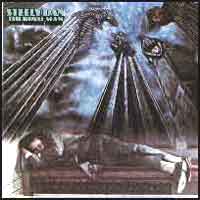 Mal wieder ein Meisterwerk von Walter Becker und Donald Fagan.
Inzwischen war die "Band" aufgelöst und wir hören stattdessen die besten Studiocracks von
New York und L. A. bei der Umsetzung der Ideen der beiden genialen Songschreiber:
Chuck Rainey (bg), Don Grolnick (p), Paul Griffin (p), Rick Marotta (dr),
Michael McDonald (v), Dean Parks (g), Bernard Purdie (dr), Larry Carlton (g) und andere.
Mal wieder ein Meisterwerk von Walter Becker und Donald Fagan.
Inzwischen war die "Band" aufgelöst und wir hören stattdessen die besten Studiocracks von
New York und L. A. bei der Umsetzung der Ideen der beiden genialen Songschreiber:
Chuck Rainey (bg), Don Grolnick (p), Paul Griffin (p), Rick Marotta (dr),
Michael McDonald (v), Dean Parks (g), Bernard Purdie (dr), Larry Carlton (g) und andere.

 Spätestens
seit diesem dritten Album bzw. seit den ausgedehnten Touren 1974/75
zum erfolgreichen zweiten Album "
Spätestens
seit diesem dritten Album bzw. seit den ausgedehnten Touren 1974/75
zum erfolgreichen zweiten Album " Die Experten streiten, welches von den beiden Alben der Band aus St.
Louis das bessere ist. Ich habe mich hier wegen "She Came
Shining" und "Standing Here With You" für dieses
zweite entschieden. Beeindruckend bei der Band war immer der hohe Gesang
von David Surkamp - mit niemandem anderen vergleichbar. Nach
dieser Platte verschwand Surkamp wieder in der Versenkung, tauchte nur
mal kurz 1982/83 in der Band
Die Experten streiten, welches von den beiden Alben der Band aus St.
Louis das bessere ist. Ich habe mich hier wegen "She Came
Shining" und "Standing Here With You" für dieses
zweite entschieden. Beeindruckend bei der Band war immer der hohe Gesang
von David Surkamp - mit niemandem anderen vergleichbar. Nach
dieser Platte verschwand Surkamp wieder in der Versenkung, tauchte nur
mal kurz 1982/83 in der Band  Wie kommt der Kerl hier jetzt nur auf dieses schlappe Stones-Album? Es gibt doch so viele bessere!
Wie kommt der Kerl hier jetzt nur auf dieses schlappe Stones-Album? Es gibt doch so viele bessere! 1976 hatte die Band wohl wirklich "einen Lauf" mit gleich zwei
Alben - aber es liegen ja doch immerhin 11 Monate zwischen "
1976 hatte die Band wohl wirklich "einen Lauf" mit gleich zwei
Alben - aber es liegen ja doch immerhin 11 Monate zwischen "